Getting going
My planned early start didn’t exactly go to plan when I woke up at about 9.30 and realised I hadn’t sent my alarm clock properly. Argh! But a glance out the window at the sun hitting the pavement soon washed away any sense of annoyance. It was so nice to see the sun again after the grim weather at home!
I had a loose plan for the day – basically to explore a bit of Lisbon’s centre using a map I’d created with interesting spots. First though… coffee. I left the hotel and turned the corner along a side street away from Avenida Liberdade – just to see what was there really. And was rewarded with the perfect view of one of Lisbon’s bright yellow trams.
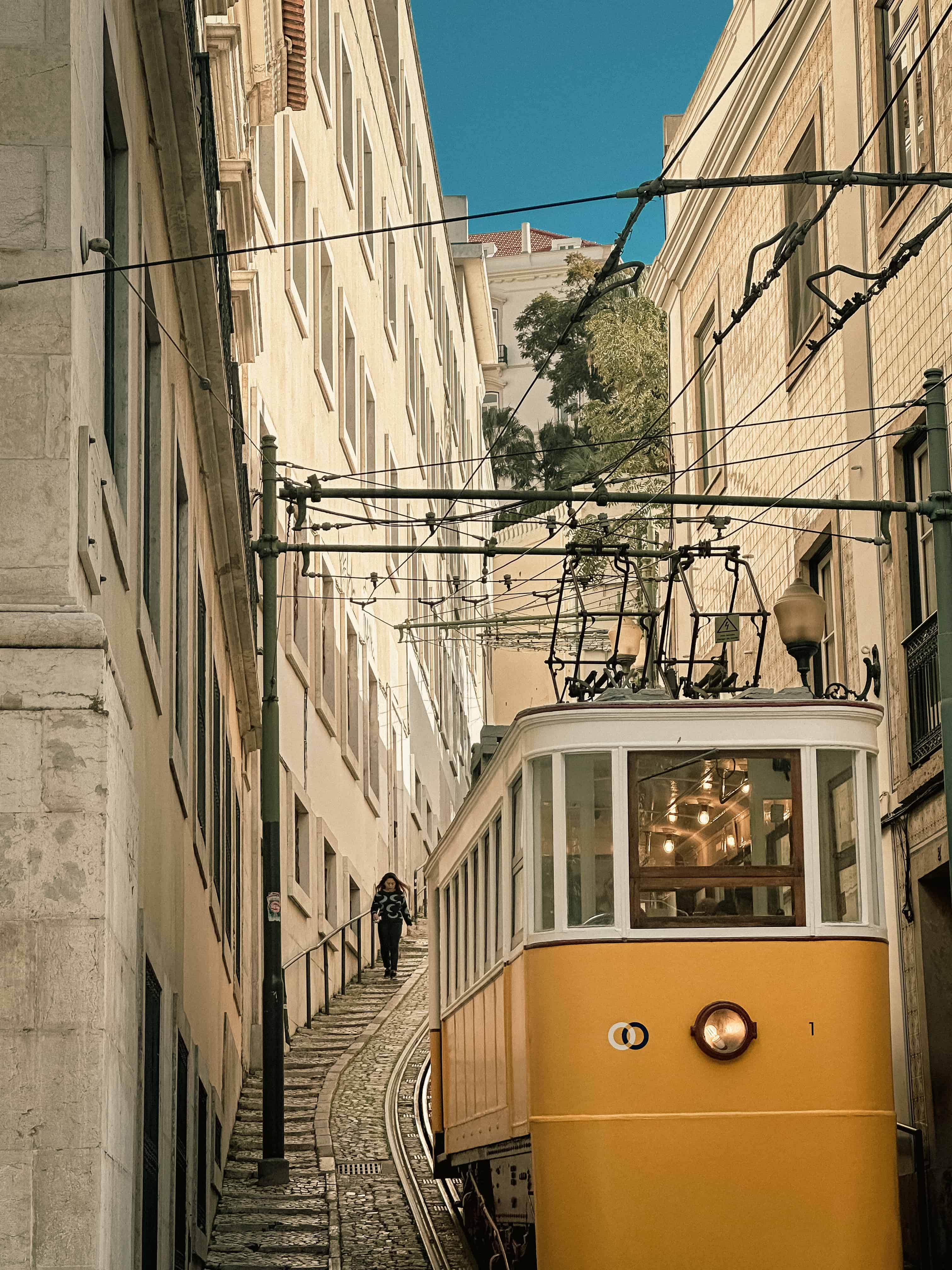
It wasn’t quite as idyllic as the picture makes as out as there was a dirty big delivery lorry smack bang in front of it, but I managed to crop that out!

Just next to the tram stop was a branch of Simpli Coffee – a roastery and cafe, which seemed like a perfect place to get my caffeine fix. A large Americano to go and I was soon on my way into the town centre.
It’s got to be said some of Lisbon’s buildings are just beautiful. There are the tiled exteriors the city is famous for of course, but there are also some amazing examples of art deco architecture.
One was just down the road from my hotel – a theatre – the view of which was slightly marred by a massive lamppost and other street furniture…
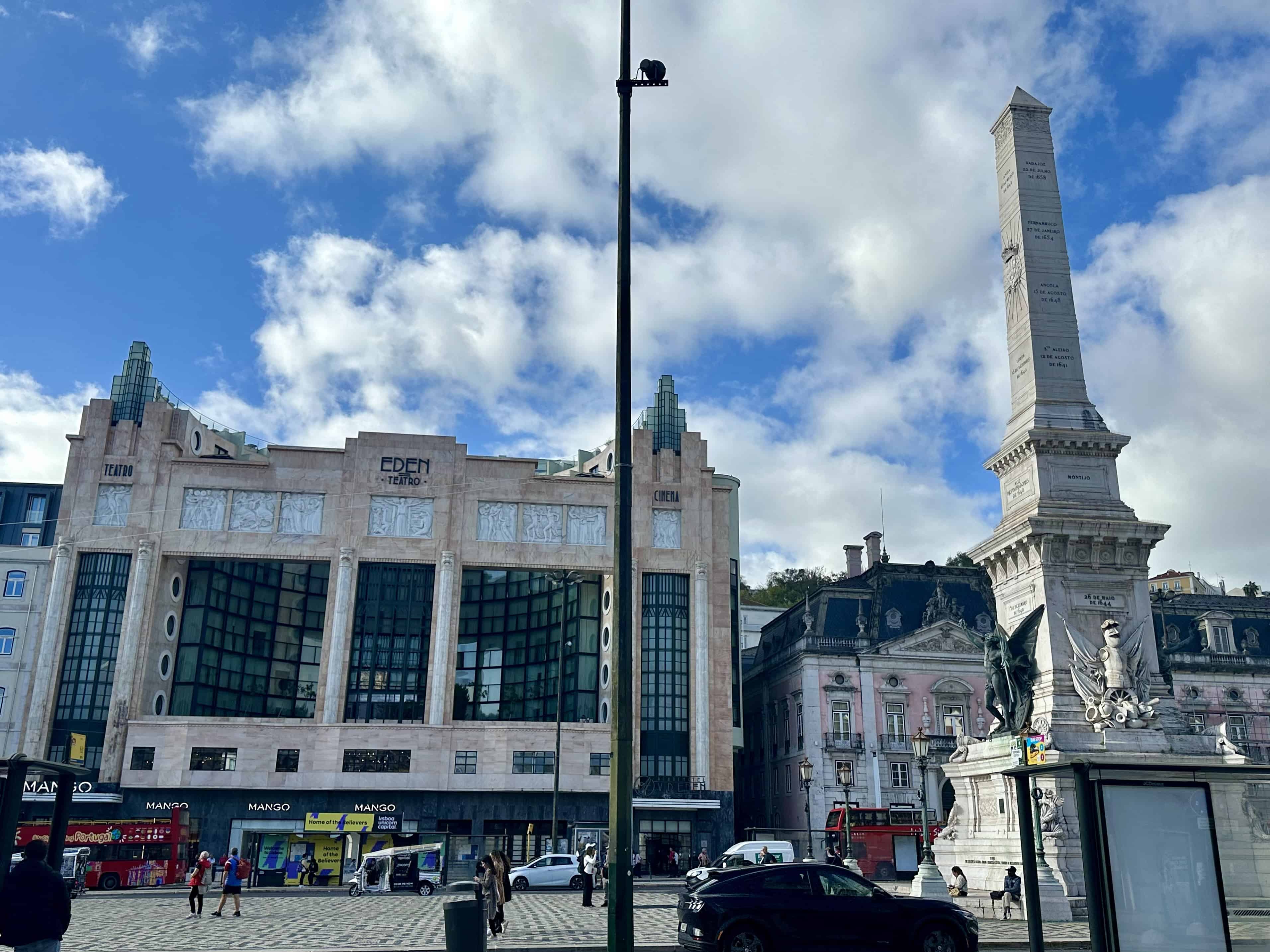
While this shop and what looked like apartments above caught my eye too.
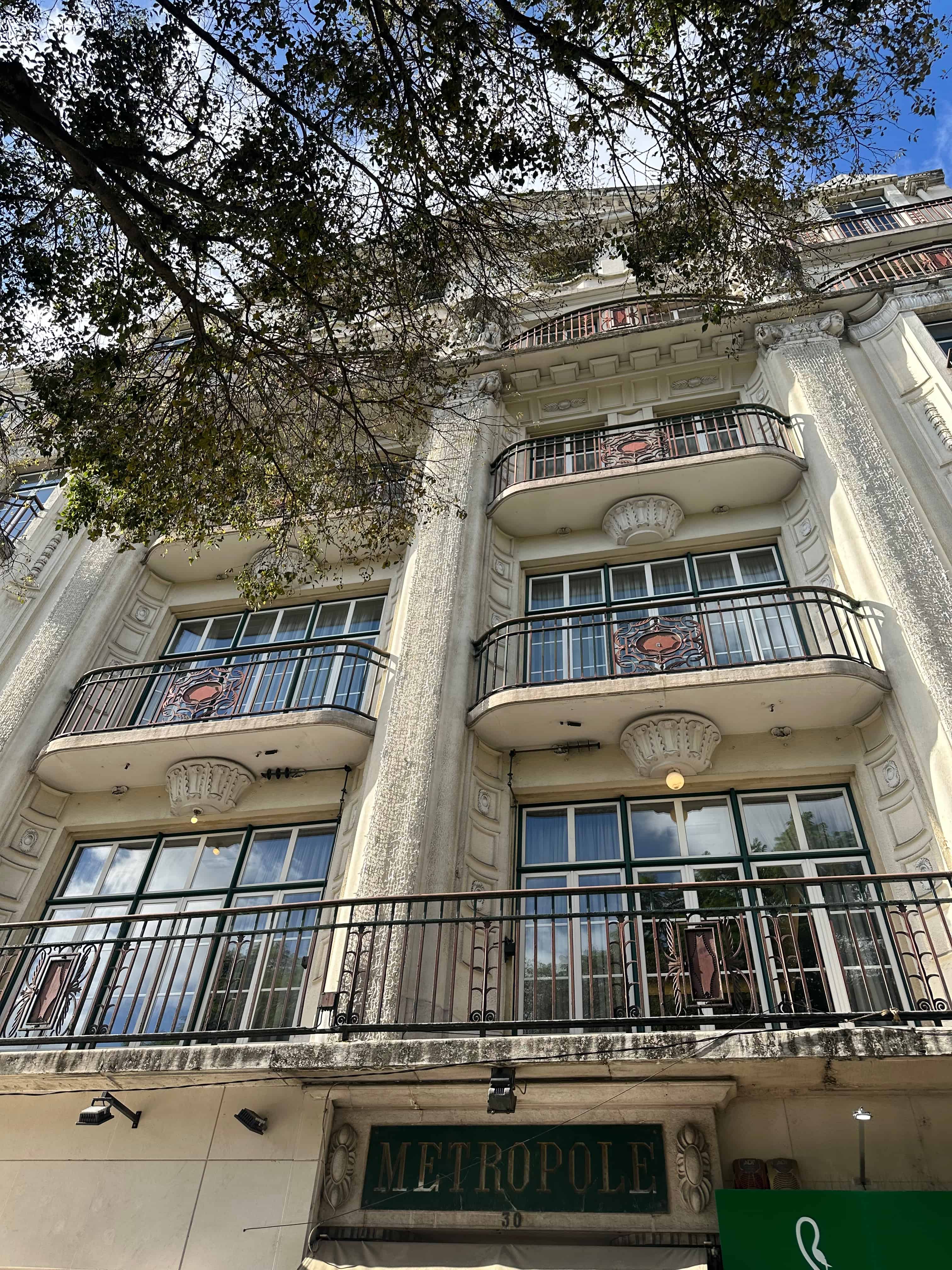
A bit of breakfast
I was a bit peckish, and thought I’d start the day with a particular Portuguese pastry, but first headed off to find an ATM so I had some cash to hand.
It turned out to be quite the hunt. The first ATM I found didn’t allow me to withdraw any money, only check my balance.
Using Apple Maps I clambered up stairs through backstreets to the next closest ATM. I never found it, but I did come across an amazing display of street art dedicated to the Portuguese style of music called fado.

Isn’t that amazing? I also found a great example of one of those tiled houses – which just goes to show you’ll never know what you’ll find on a detour!
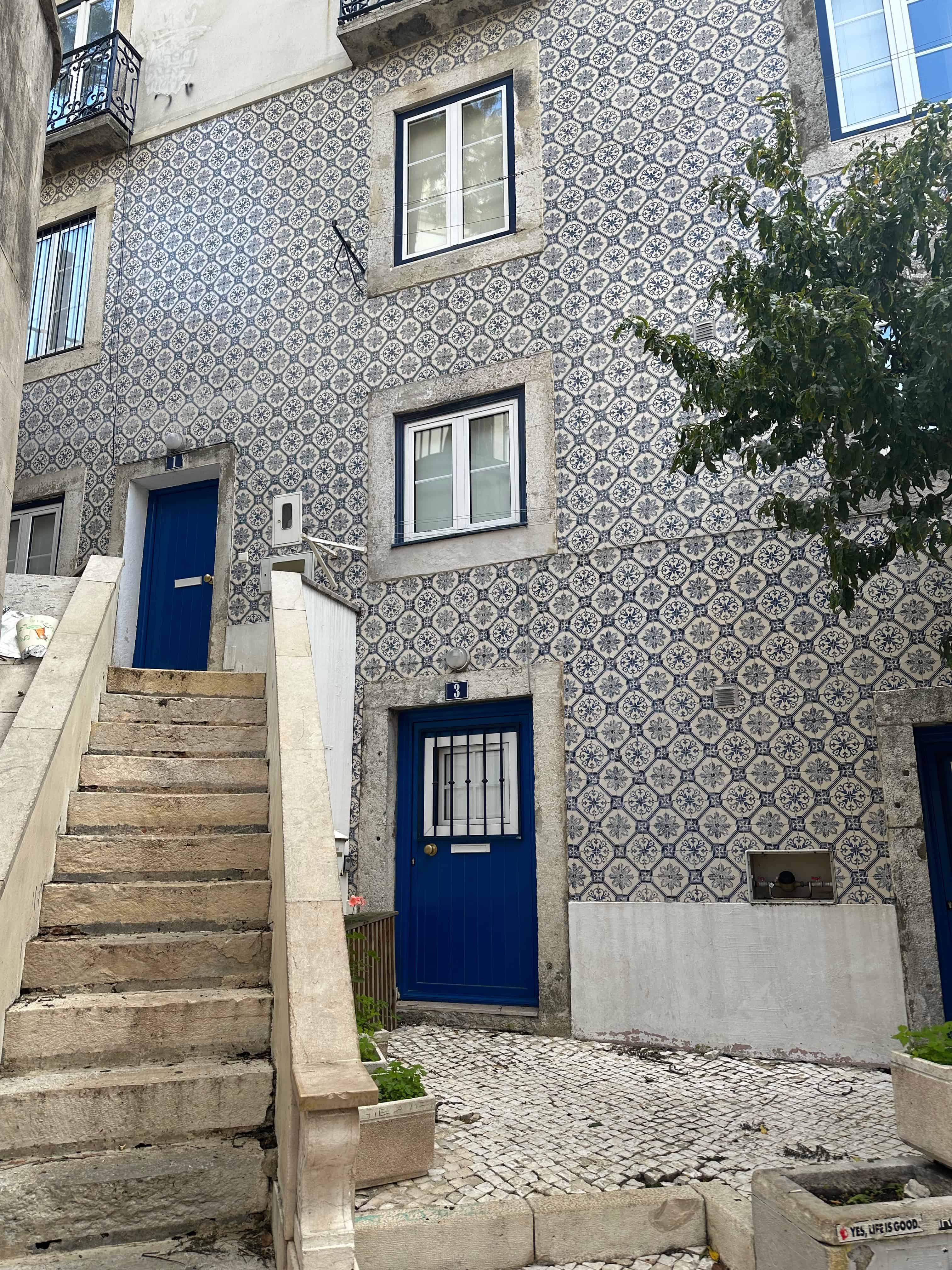
The next ATM I found had an out of order screen which meant once you put your card in you couldn’t do anything. By now I was beginning to get very cheesed off! Eventually however, I found a working machine, and walked to Confeitaria Nacional, tucked away on a street just off Lisbon’s Rossio Square.
If there’s one treat synonymous with Portugal, it’s the pastel de nata. Originally made before the 18th Century by Catholic monks with leftover egg yolks, the small pastry consists of a pastry case filled with egg custard. And according to many guidebooks, Confeitaria Nacional is the best place to try them.

The pastry shop and café was founded in 1829 – and it was home to Lisbon’s first telephone some forty years later. I stepped inside and just gazed at the cakes on display and old style interiors.
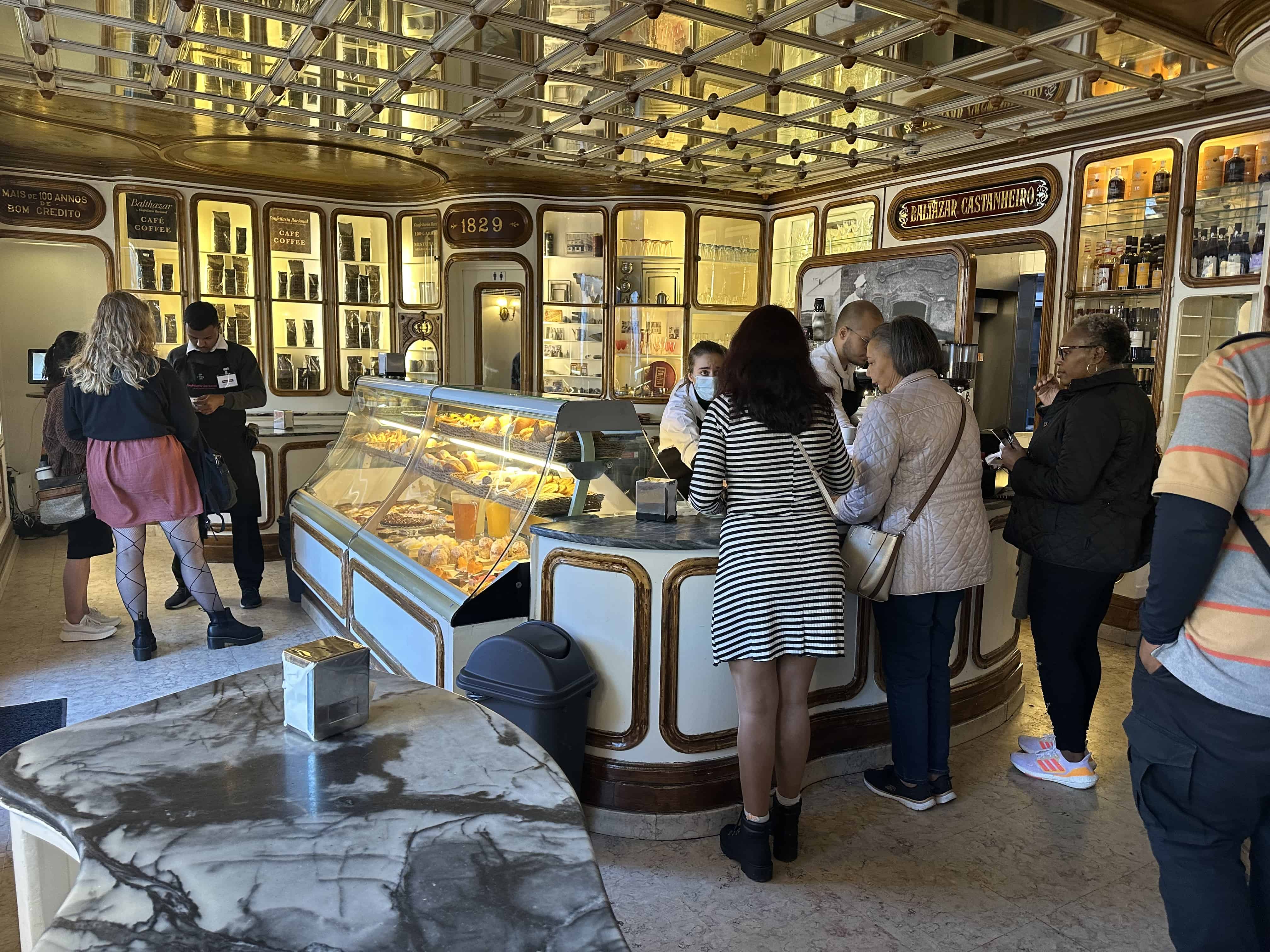
Most of the people inside were tourists. And that’s something I noticed throughout my time in Lisbon. Despite it being very much ‘off’ season, there were tourists absolutely everywhere. The city was hosting a web summit while I was there – the local public transport authority had laid on extra buses and so on to manage the crowds of delegates – so no doubt a large proportion of people had come for that.
But almost everywhere I turned in Lisbon all I could hear were tourists – from one country in particular – speaking REALLY loudly. I felt maybe like Iceland and Barcelona, Lisbon’s perhaps becoming a victim of its own success, and being slightly overwhelmed by tourists. Of course I was adding to the problem being a tourist myself, but the relentless experience of people stopping right in front of you to take a photo of a random building or tree became a bit exasperating at times. At least I was trying not to do that!
Anyway, back to the cake in hand. I bought two pastéis de nata, and stepped outside to enjoy the crunchy softness as the sun shone on my face. The pastéis came with a packet of powdered cinnamon and one of sugar. I just sprinkled the cinnamon one on top.
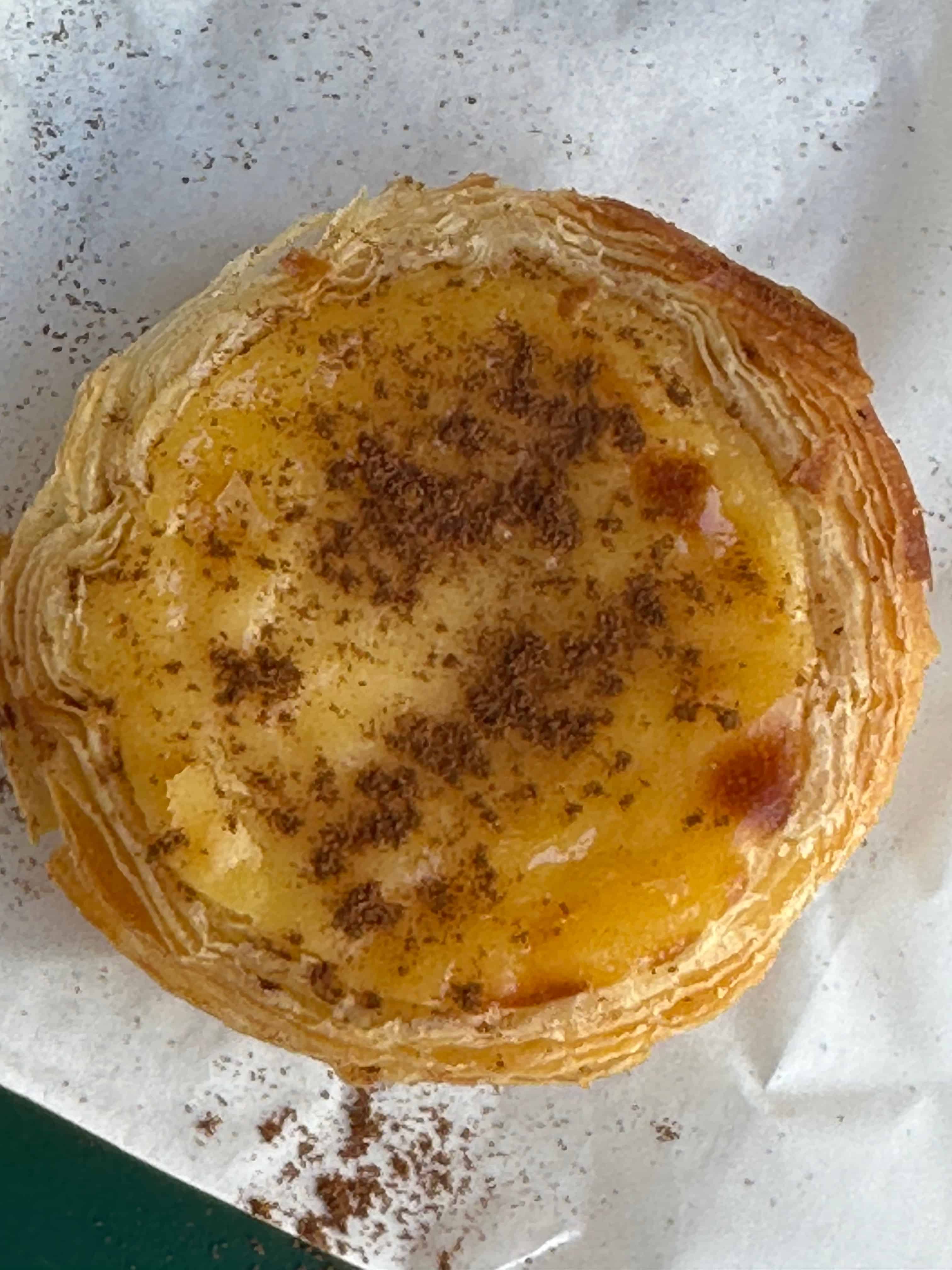
And took a bite.
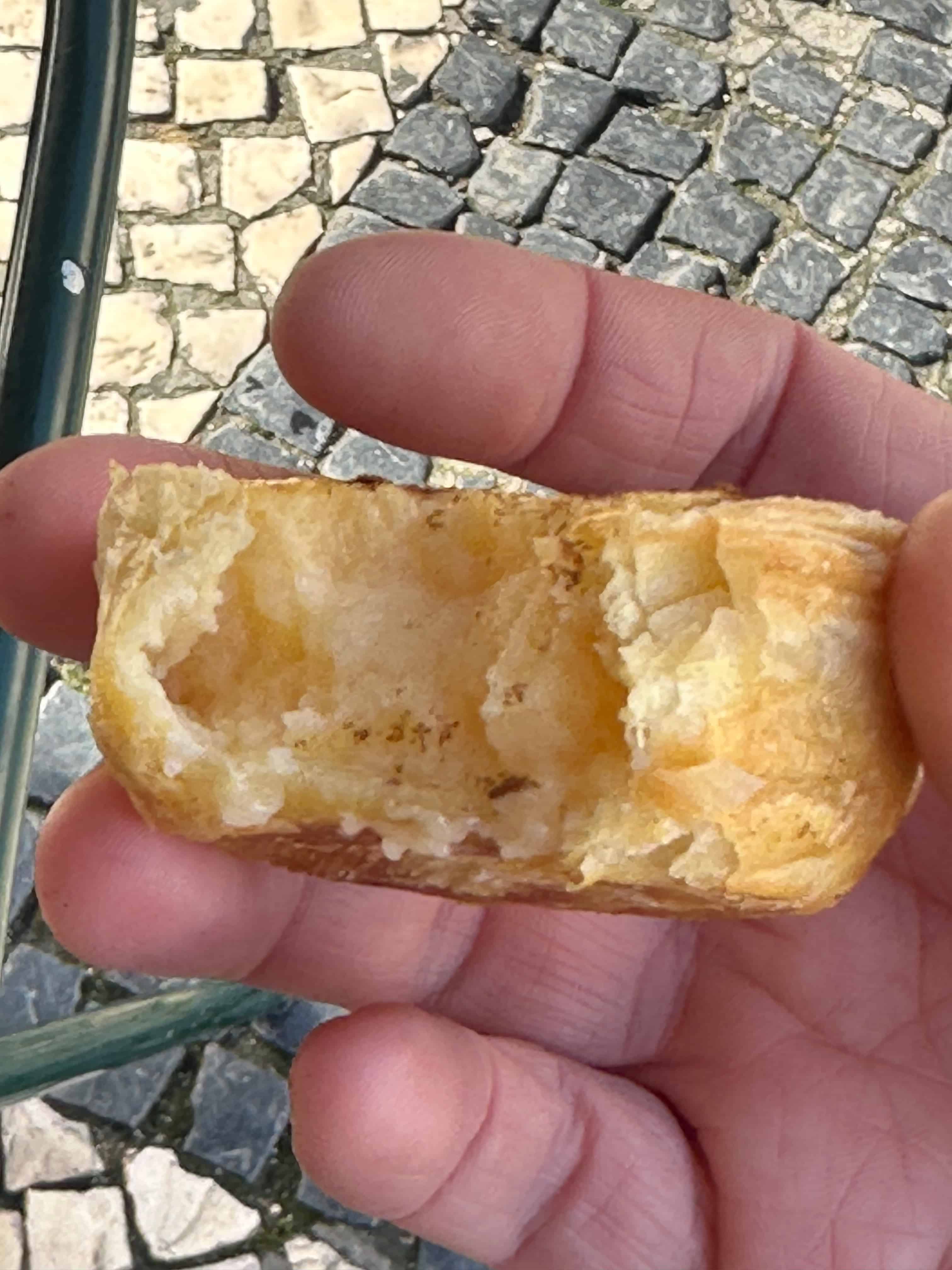
Delicious – there’s no two ways about it! However this definitely wouldn’t be the best example of a pastel de nata that I had on my trip. With the benefit of hindsight, I’d describe it as average!
A lift with a view
After a quick look in Ale-Hop (kind of like Tiger but a bit more expensive) I turned the corner for what was the first kind of tourist attraction of my visit. Lisbon is a city of hills and steep slopes, and in 1902 one solution opened to help the city’s inhabitants get from Baixa to the higher Carmo Square, or Largo do Carmo.
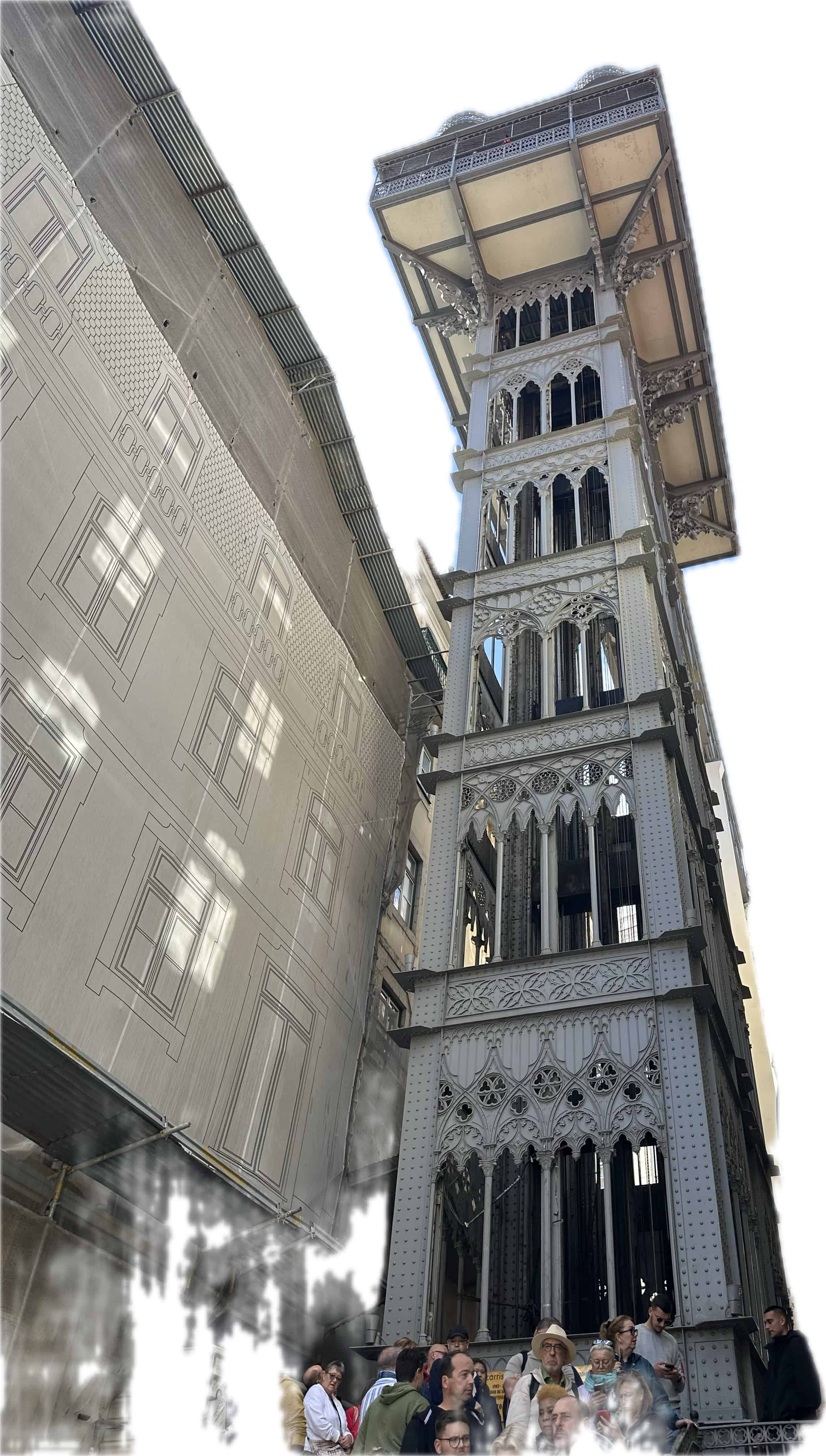
Today the Santa Justa lift seems to be more of a tourist attraction than something regularly used by the people of Lisbon, but it’s one of four early-20th-century elevators still in operation in the city. It is, however, the only vertical one – the others are funiculars which run on diagonal slopes. If you have a 24 hour public transport ticket that covers your ride in the lift, though not the fee to access the viewing deck. If you don’t have a 24 hour ticket, a return trip in the lift is €5,30.
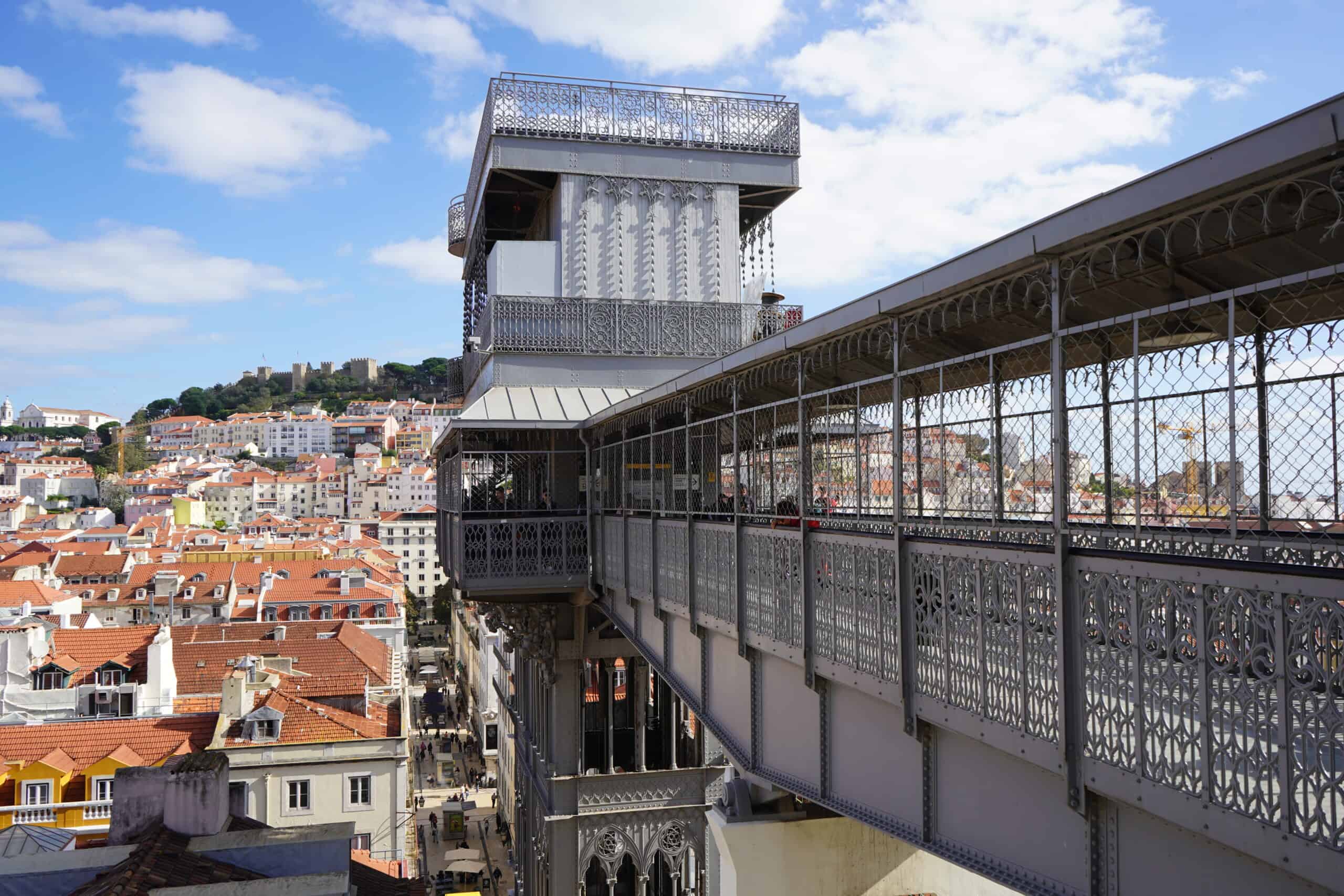
The viewing deck right at the top of the tower was closed when I visited – and has been for a couple of years apparently, due to safety reasons and ongoing restoration works. There is, however, another platform just one level down from that, so I’d still get a bit of a view.
When I arrived – at just before midday – there was already a long queue snaking around the bottom of the lift shaft. I definitely couldn’t be bothered waiting in that! And thankfully I didn’t have to either. A quick google brought up a really helpful site which pointed out that you don’t actually need a ticket – or to pay – to get up to the platform that’s still open – and the one the lift takes you to.
I couldn’t make head nor tails of the directions on the website so instead just climbed up stairs and snaked around streets until I got to where I thought the top of the tower should be – and came out in this square.
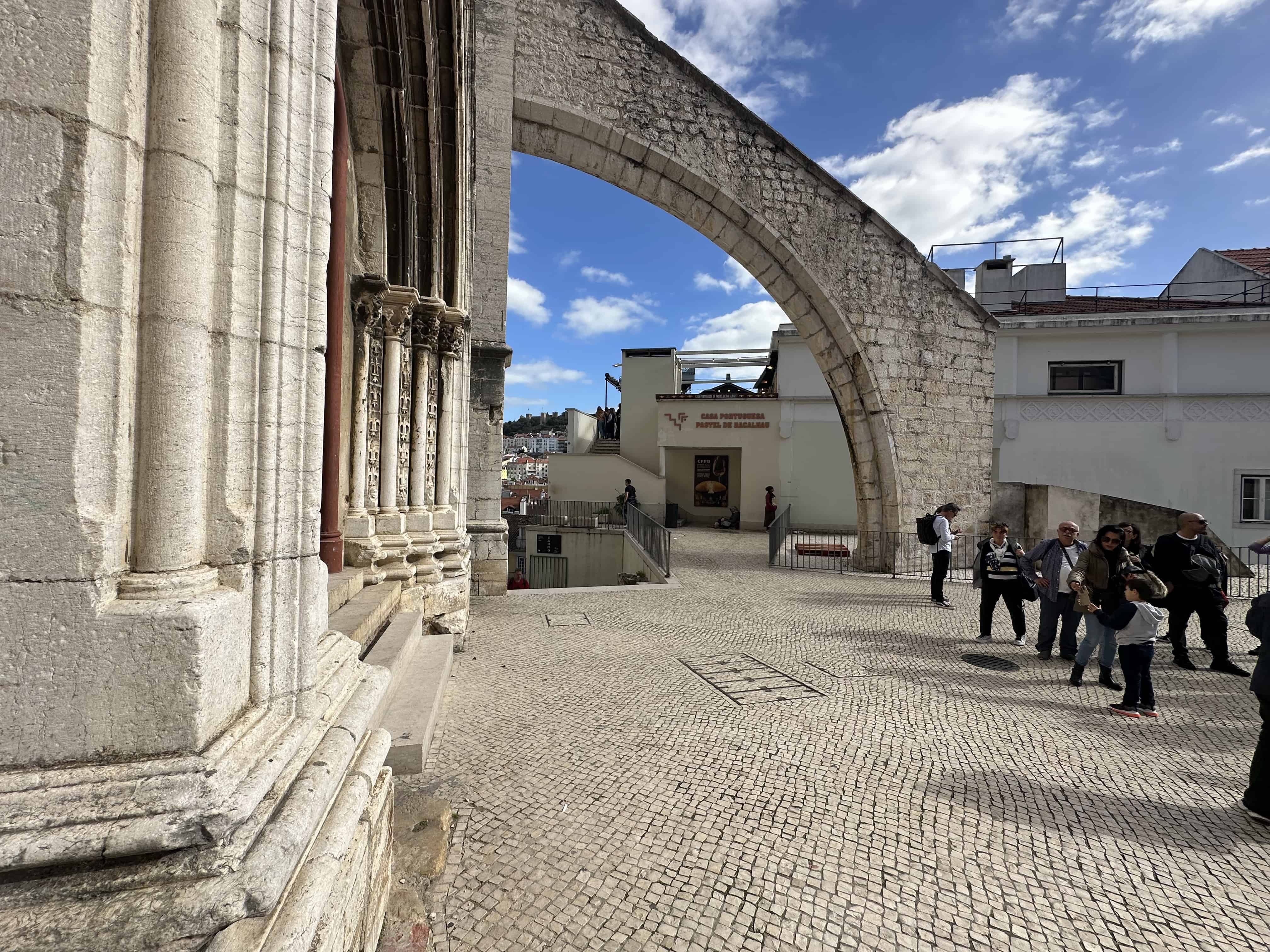
Basically you’re looking for the Casa Portuguesa café which is right beside the walkway to the viewing area. The stairs in the middle of the picture above will get you there.
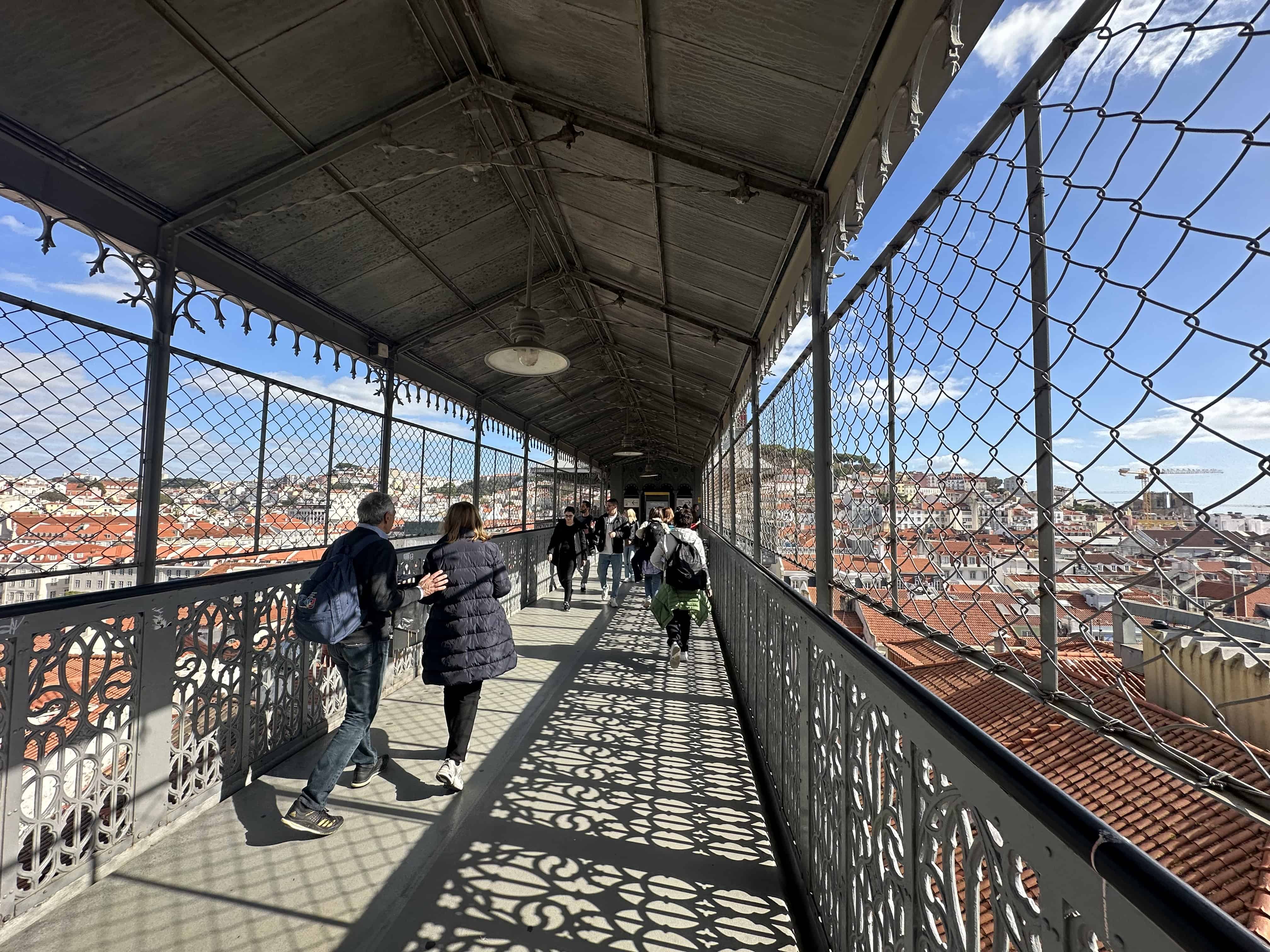
The sun was out in full force as I proceeded along the walkway.
Thankfully the viewing area itself wasn’t all that crowded. It was possible to get right up to the edge and get an unobstructed look at Lisbon.

The city looked great in the November sunshine.
A tinned food specialist
After taking the view in for a good while, I climbed back down the stairs and went to check off a couple of nearby shops on my list. First up was FNAC – it’s a French chain which we don’t really have an equivalent of in the UK, but I absolutely love it. It’s a bookstore, CD / game specialist and electronics store all rolled in to one, and there was one tucked away in a shopping centre just a stone’s throw from the Santa Justa lift.
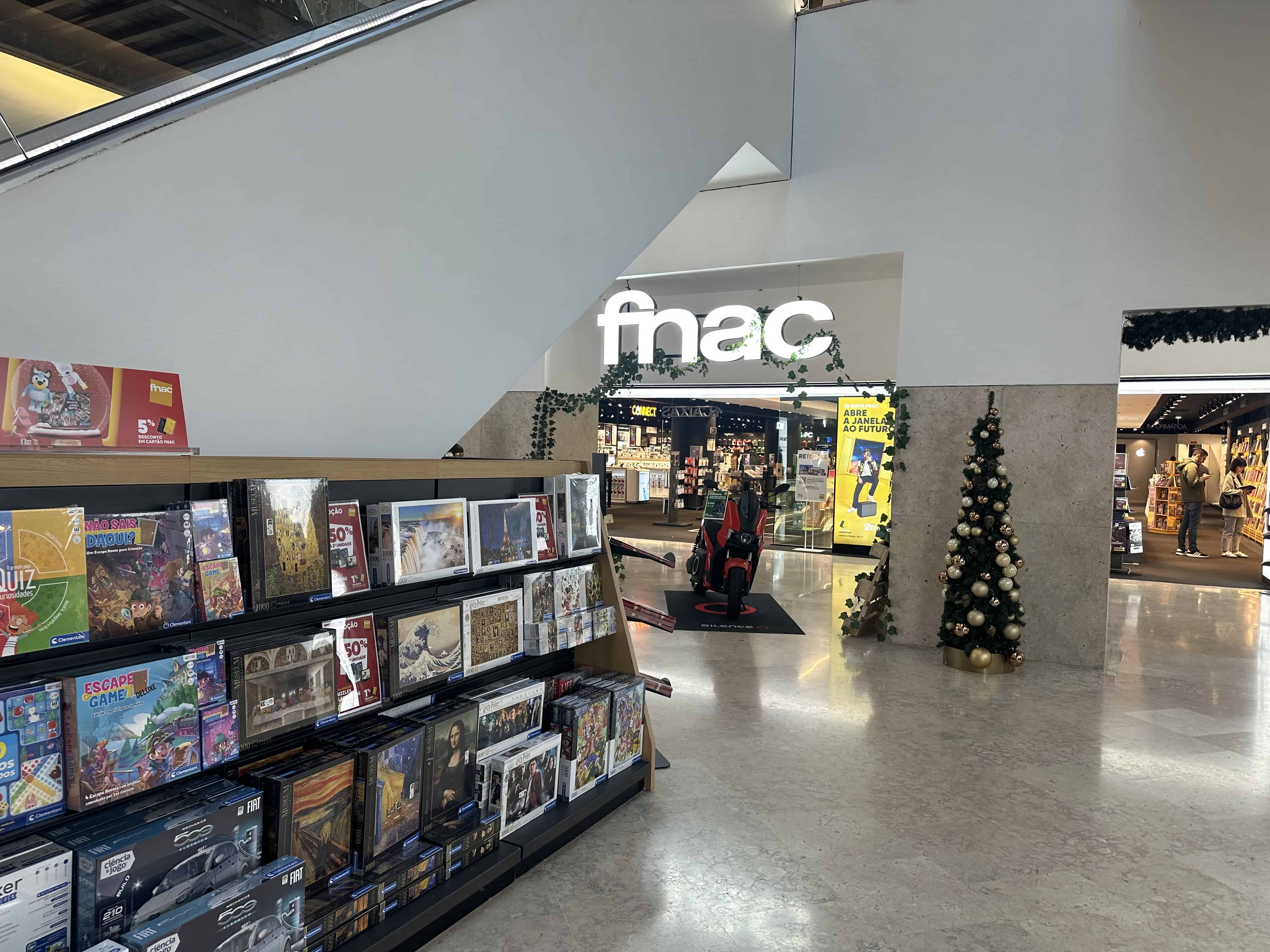
I spent a while browsing around before heading back out on to the streets. I really wish FNAC would come to the UK!
Next on my list was a more traditional kind of store. On my way there I passed one shop – A Conserveira de Portugal – which sold the same goods.

I had a quick look – but it seemed to be really geared towards tourists.

I’m not sure what a jeep has to do with the goods they’re selling! Fair play to that company though – they even have a store in Times Square, New York now. Not even five minutes walk away, though, is Conserveira de Lisboa, a store originally founded in 1930.
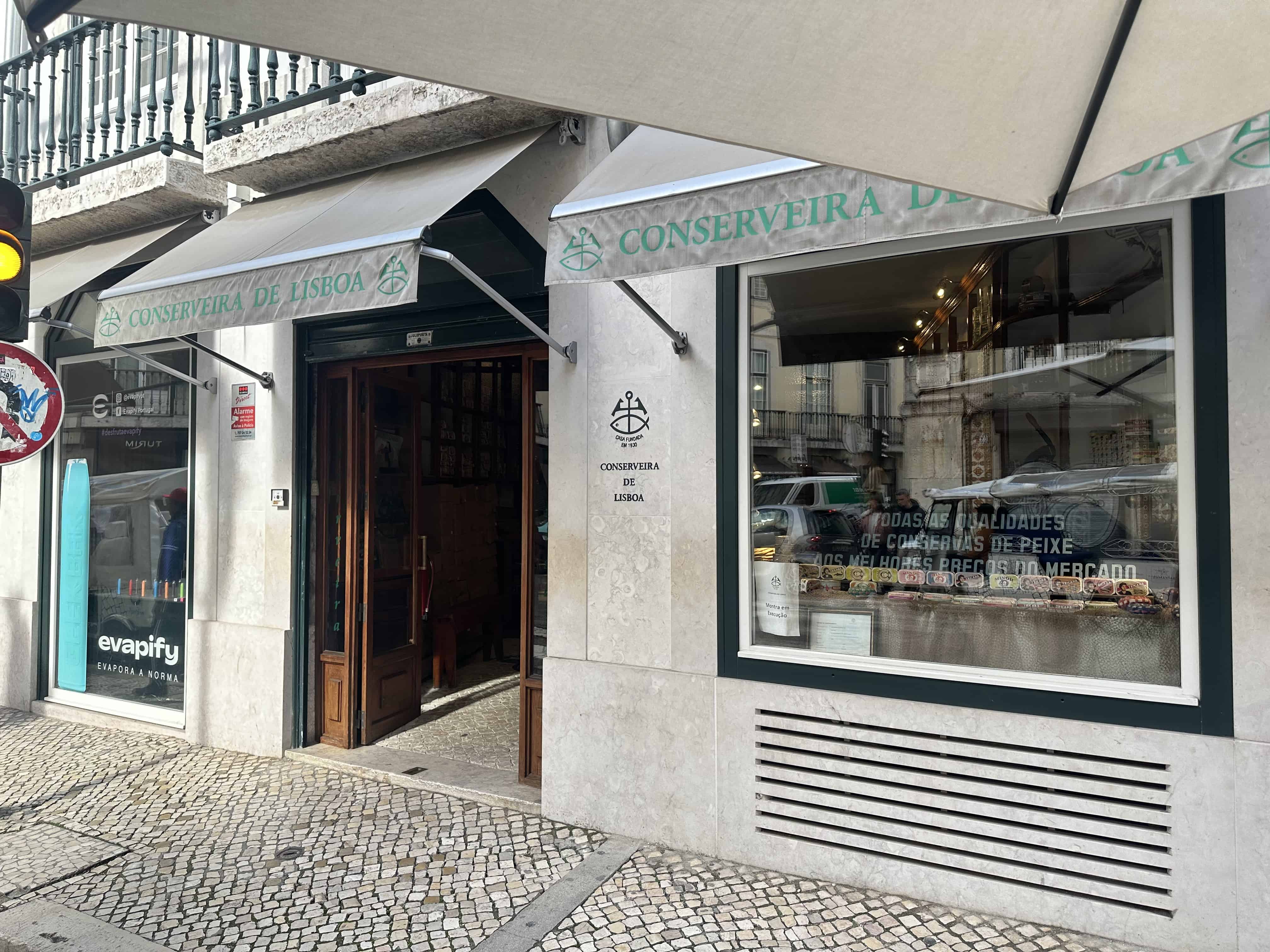
Inside looked like a much more authentic experience. I don’t know – it may be geared towards tourists too but it didn’t feel like it! Tins of food lined old wooden display shelves, and a till from what looked like the early 1900s sat proudly on the counter.
Conserveira de Lisboa sells one thing and one thing only – canned fish. There was tin upon tin of tuna, horse mackerel, mussels – and of course, the fish Portugal is most famous for. Sardines.

I LOVE sardines – they’re probably my favourite fish, so it was a no brainer I was going to buy some here. And Conserveira de Lisboa has a big choice. There’s sardines in Oregano. Sardines with Lemon. Sardines with spicy pickle, with garlic, with curry sauce! In short, you name it and they have sardines in it!
I asked the guy behind the counter to explain what the various options were that were laid out on a small tray, but really wish I’d checked out the list of options available on their website first – there were a lot more there than he mentioned. I picked up a tin of sardines in olive oil, with lemon, and of course – with spicy pickles. They were about €3 per tin – so definitely not your 65p job from Sainsbury’s, but a perfect souvenir of the city and I’m looking forward to trying them.
A look at the darker side of Portugal’s history
It was just after 1pm by this point and I felt I’d already packed a lot in to my day! But it was time for me to cross another place off my list. One recounting a piece of Portugal’s history I actually hadn’t known about until I started researching the city.
Tucked beside Lisbon’s Cathedral is a building which is now a museum, but which once held something much darker. I hadn’t known until I read about the museum that Portugal had once been under a military dictatorship. I knew about Franco in Spain, and that Argentina had had a similar experience, but I’d never realised that for nearly fifty years Portugal had suffered the same fate.
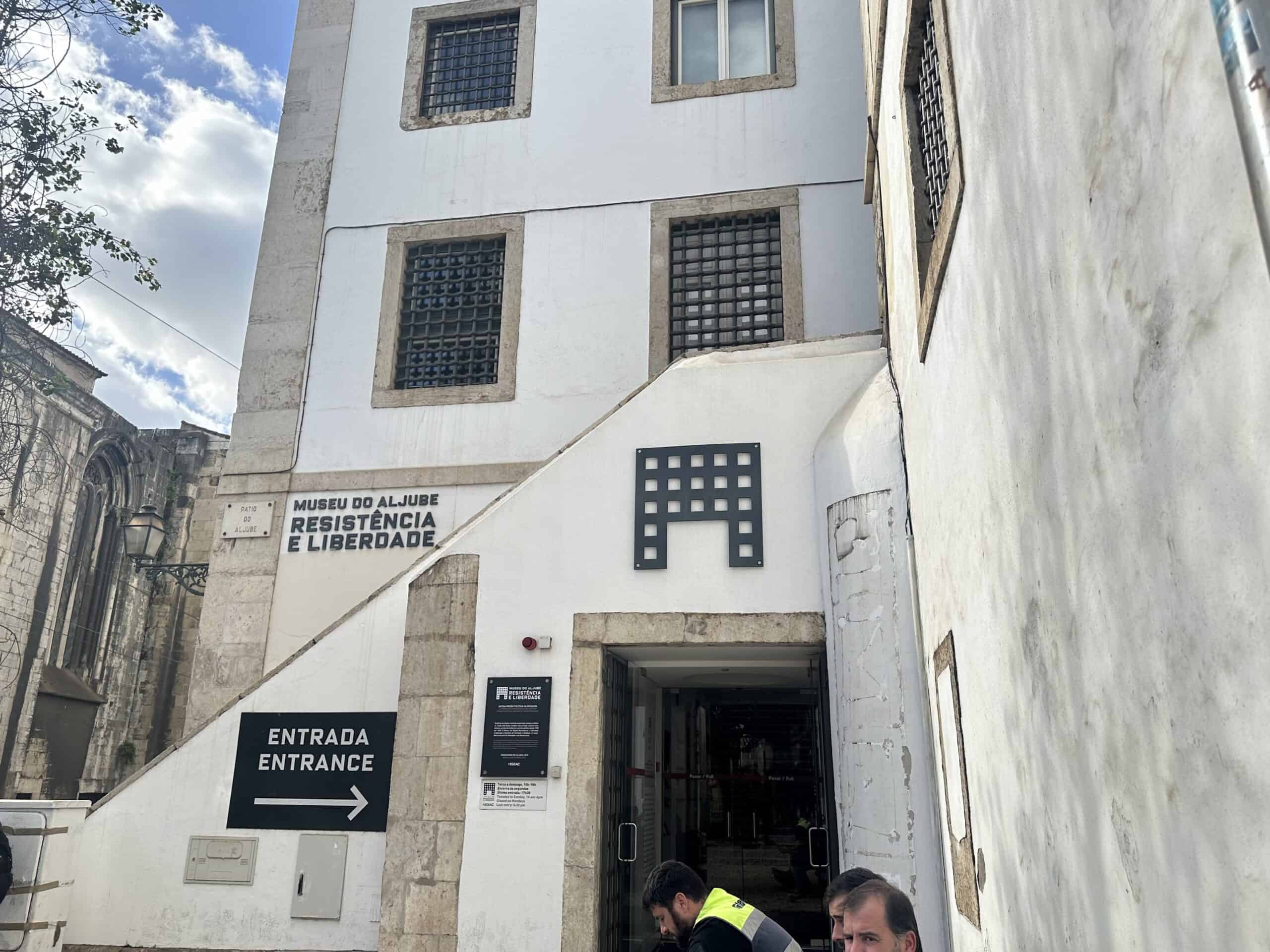
The white-walled building sitting in the shadow of the imposing Sé de Lisboa and which I was now standing outside had, during that period, been Aljube prison – a private prison for the political police.
Whether it’s the Stasi in Berlin or political police in Portugal, there’s something I just find fascinating – if a bit depressing – about state suppression and surveillance. So pretty early on I’d marked the Aljube Museum of Resistance and Freedom as somewhere to visit. Entry is just €3.
Handed a simple guide, I made my way up the small staircase to the first floor, where the exhibits began.
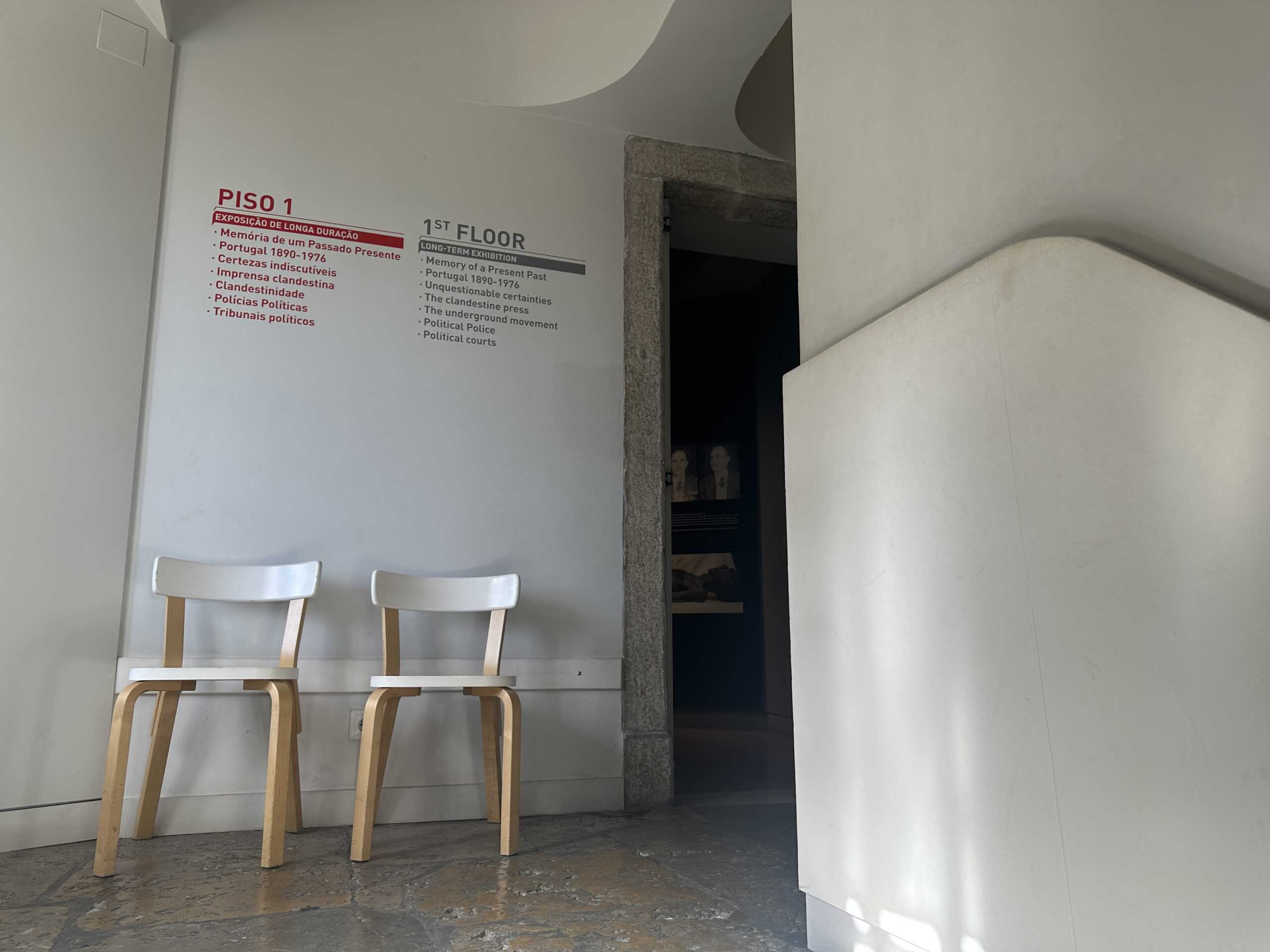
Straight away I was worried I wouldn’t be learning very much. The first room contained numerous displays which were only in Portuguese. I started to translate some using the camera on my phone but quickly realised that was going to make for extremely slow progress!
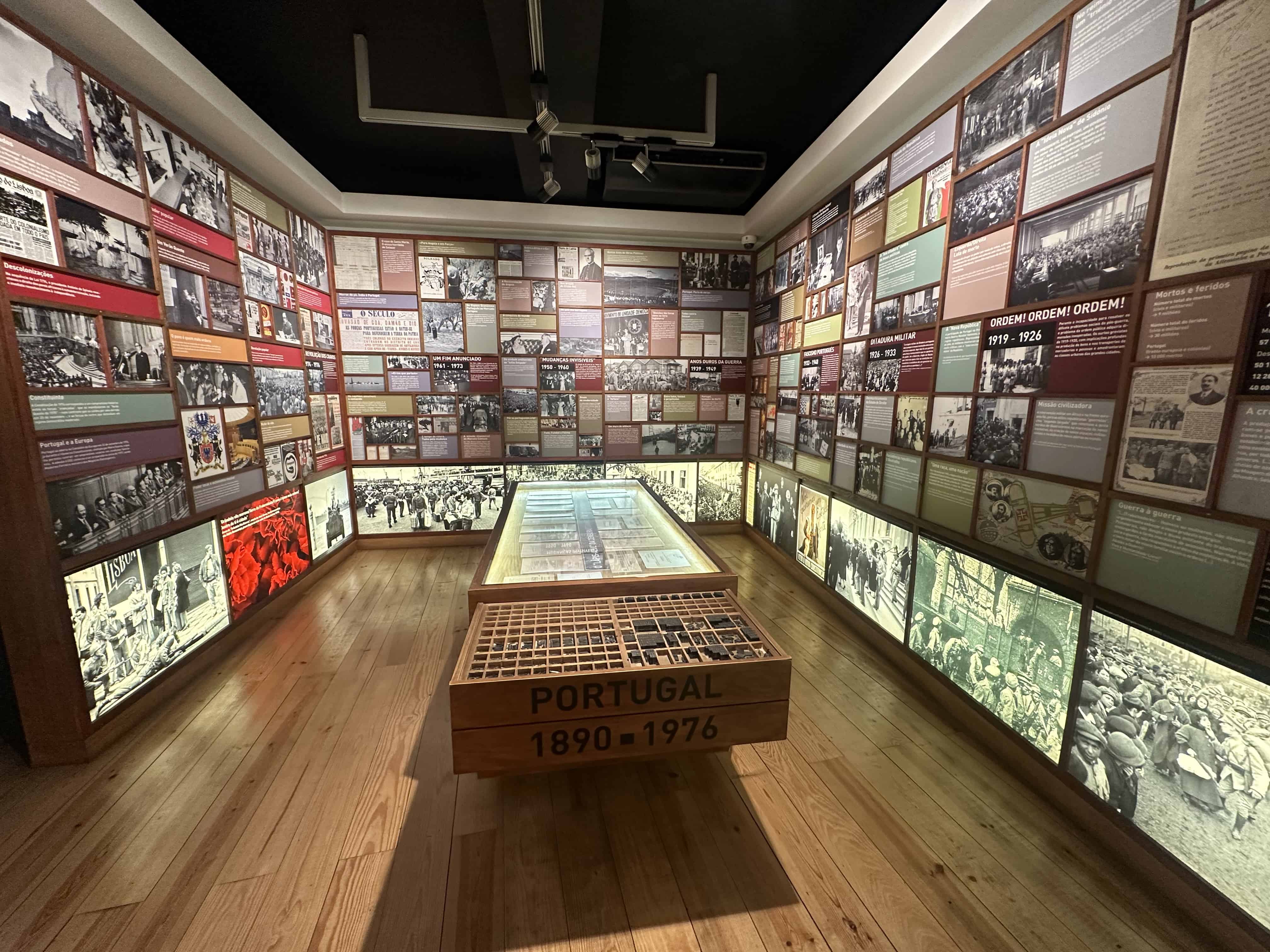
Stepping into the next room however, I found English translations alongside the Portuguese version. The first floor was all about Portugal between the period of 1926 and 1974 – when the dictatorship was in place. Some of the images I found really menacing – it seems like as had happened elsewhere, charismatic people had just swept into power.
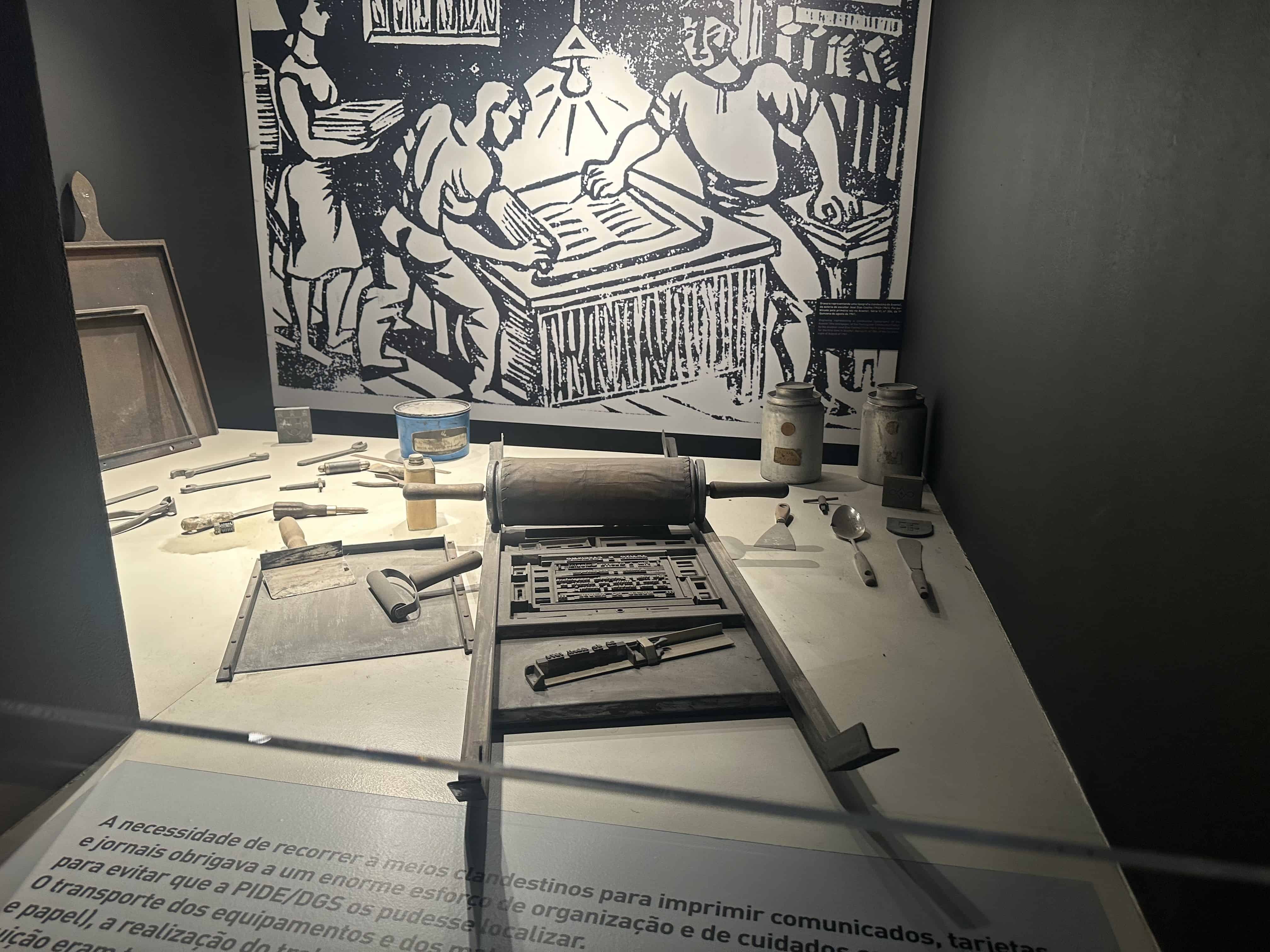
Other exhibits on the floor covered opposition to the dictatorship and the political courts system set up to allow the political police (PIDE) to get away with punishing anyone that got in their way.
As I walked around the exhibit I just kept thinking “how could this have happened?” Portugal was obviously a civilised country. But then I just remind myself of the growth of the far-right in Europe of late. When you think about that you can kind of understand how these people that ruled their countries with an iron first could get into positions of power.
Moving up to the second floor, the story turned to the Resistance movement, and the brave men and women that tried to oppose the government. It would be a long hard slog for them. Portugal would be ruled by a dictatorship for 48 long years.
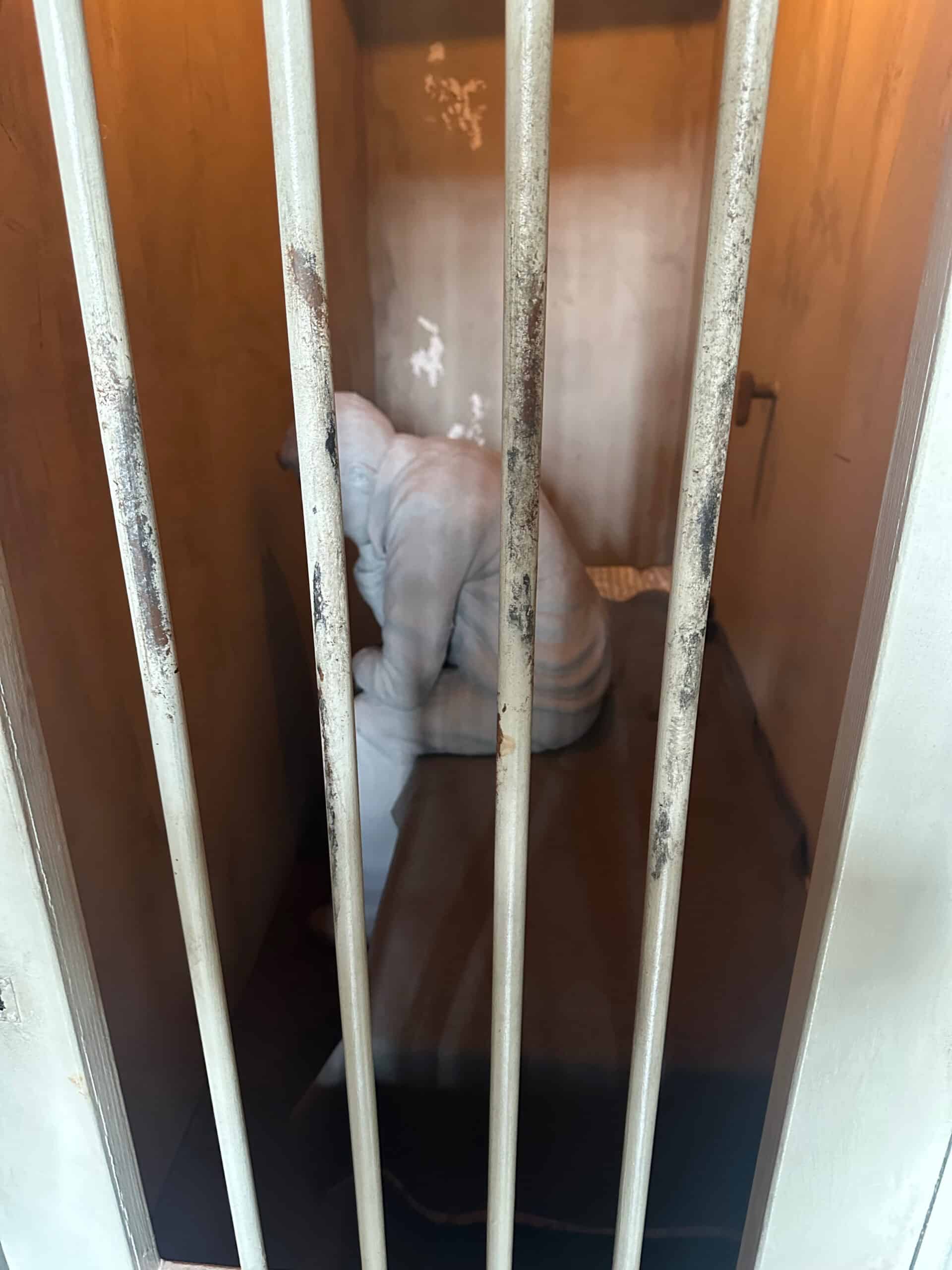
Also on the second floor was a mock up of the type of cells prisoners at Aljube experienced. And it was pretty grim. The building held 14 gavetas – solitary cells measuring only about 1×2 metres, with no natural light. Prisoners could remain in their cells for a long, undisclosed amount of time which must have been mentally and physically gruelling.
Moving upstairs, the 3rd floor had an exhibition about Portugal’s colonialism in Africa, and the country’s April Revolution – when on the 25th of April 1974, the officers of the Armed Forces Movement overthrew the dictatorship.
I had a quick look on the fourth floor which had an exhibit of paintings and a view over a section of the cathedral before descending back down to the ground floor where a seasonal exhibit of photographs from the day of the revolution were on display. Everyone looked delighted.

One thing, however, that I read struck me. And that was that some people – older people in particular – felt life had been better under the dictatorship. I could understand that maybe crime would have been lower, and so on. But that’s not really a fair price to pay when people are being imprisoned just for having an opinion.
All in all my visit to the museum took just over an hour, but I’d found it really eye-opening. It’s great value and I’d highly recommend it if you find yourself in Lisbon.
A spot of lunch
By now my stomach was rumbling, so I jumped on one of Lisbon’s brightly coloured trams to whisk me to a spot I’d read about.
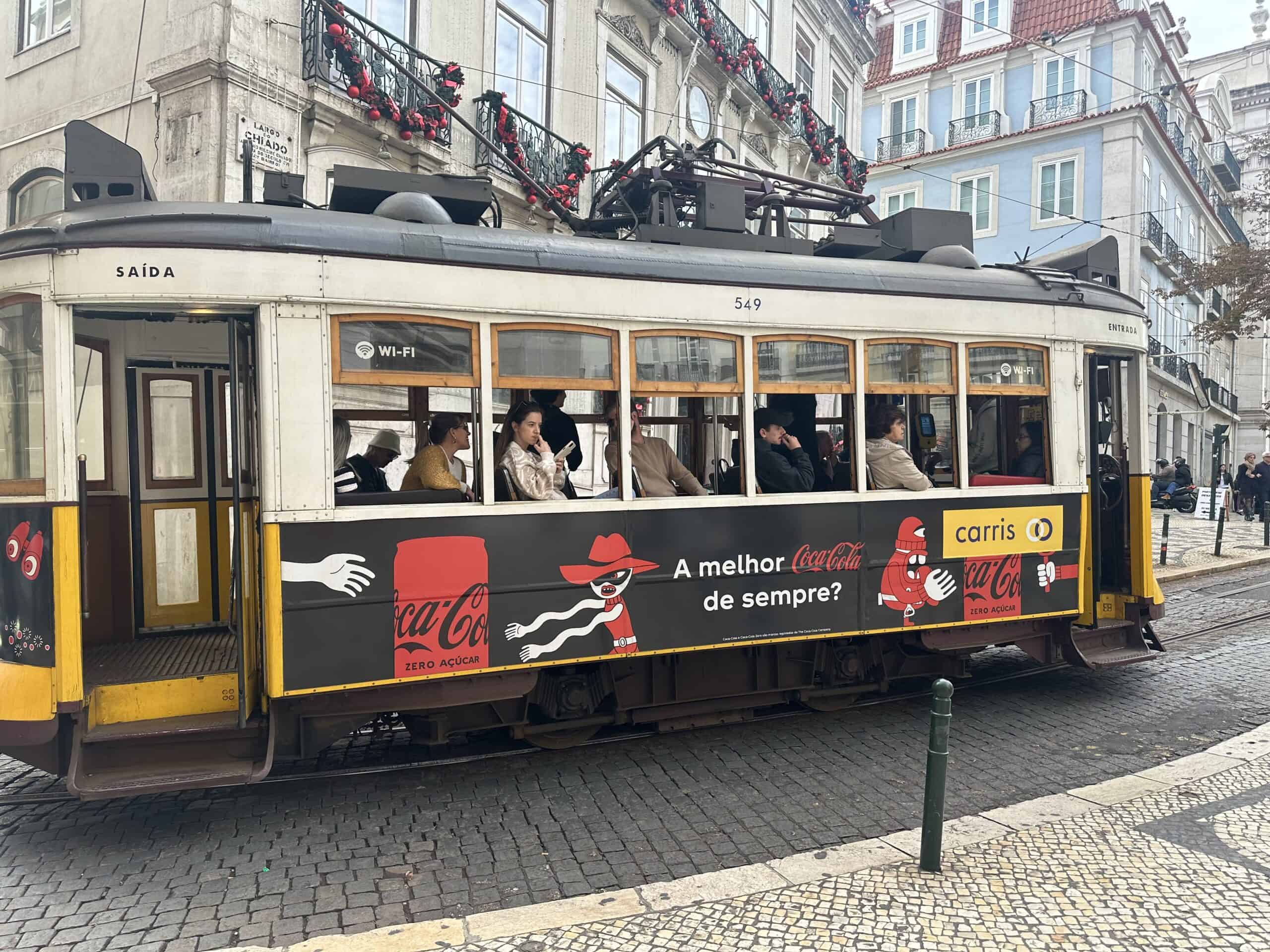
I climbed aboard the 28E tram which runs a route covered in most Lisbon tourism guides. The tram’s 45 minute long circular trip covers many of Lisbon’s sights and vistas, however I’d also read that it had become overwhelmed with tourists, meaning the city’s inhabitants were struggling to use it to get where they needed to be.
I’d deliberately avoided riding the tram for its whole route as a result, after also reading it was best to avoid the tram during peak hours so Lisbon dwellers could use it. In this instance, though, I felt jumping on the tram was justified as I was only riding a couple of stops early afternoon!
Disembarking at Ciado, it was a three minute stroll to my destination for lunch.
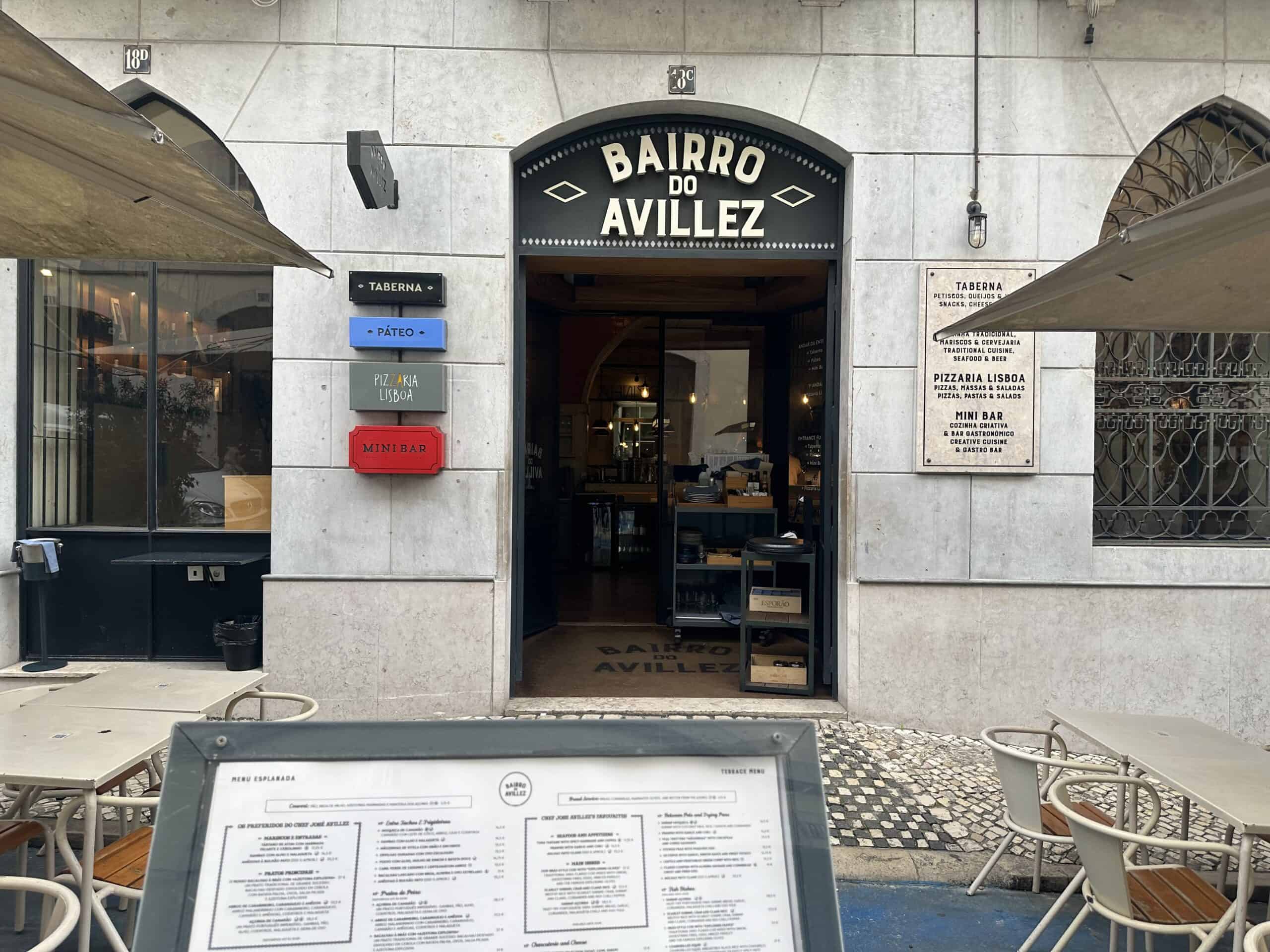
Bairro do Avillez was opened by one of Portugal’s more famous and renowned chefs, José Avillez. He’s a bit of a celebrity chef – having hosted Portuguese TV shows, he also opened the first restaurant in Portugal to gain two Michelin stars.
That wasn’t where I’d be dining though! Bairro do Avillez has four different sections – which I did find a bit confusing when I walked up to the door and was asked where I wanted to eat! There’s a Taberna with tapas, the Páteo which is mostly a fish restaurant, a pizzeria and the Minibar which is a restaurant and “gastro bar”.
I really couldn’t figure out what was going on. But I was handed a menu for the Terrace when I said I’d like to sit outside. I think the terrace maybe shares a menu with the taberna, but I can’t be sure!
Thankfully there was a menu in English – which I found to be the case most of the times I ate out in Lisbon.
I decided to go for the tuna steak sandwich with vinegary vegetables, and fries. Unfortunately what came was the steak sandwich. I’m not sure how the misunderstanding came about although I had thought it was a bit weird when the waiter asked how I wanted “it” cooked. Although I guess tuna can be served rare or medium right?

Anyway the mistake was quickly rectified, and I got two portions of fries as a result, which meant although the sandwich wasn’t enormous (but it was tasty) I was pretty stuffed after my meal! The restaurant wasn’t really too busy either, but I put that down to eating a late lunch – it was ten past three by the time the correct sandwich arrived.
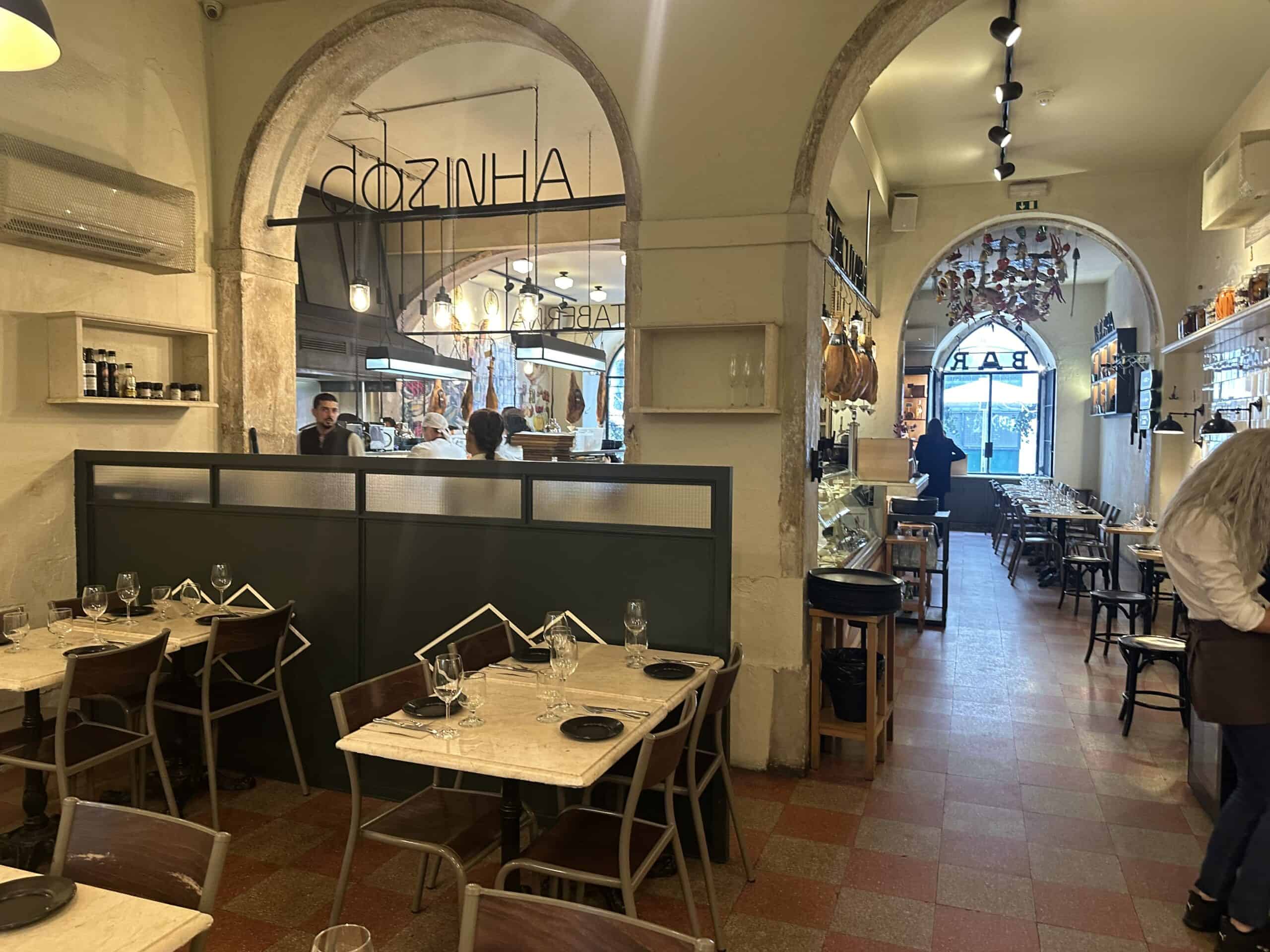
After a quick trip to the loo and a look inside Bairro’s interiors, I popped my next destination into Maps, and decided to stretch my legs climbing some more of Lisbon’s slopes on foot rather than using public transport.
Some unique shops
I passed more beautiful tiled exteriors and after a fifteen minute ascent stumbled across one of Lisbon’s many Miradouros – public viewpoints providing a vista of the city. This one was pretty busy!
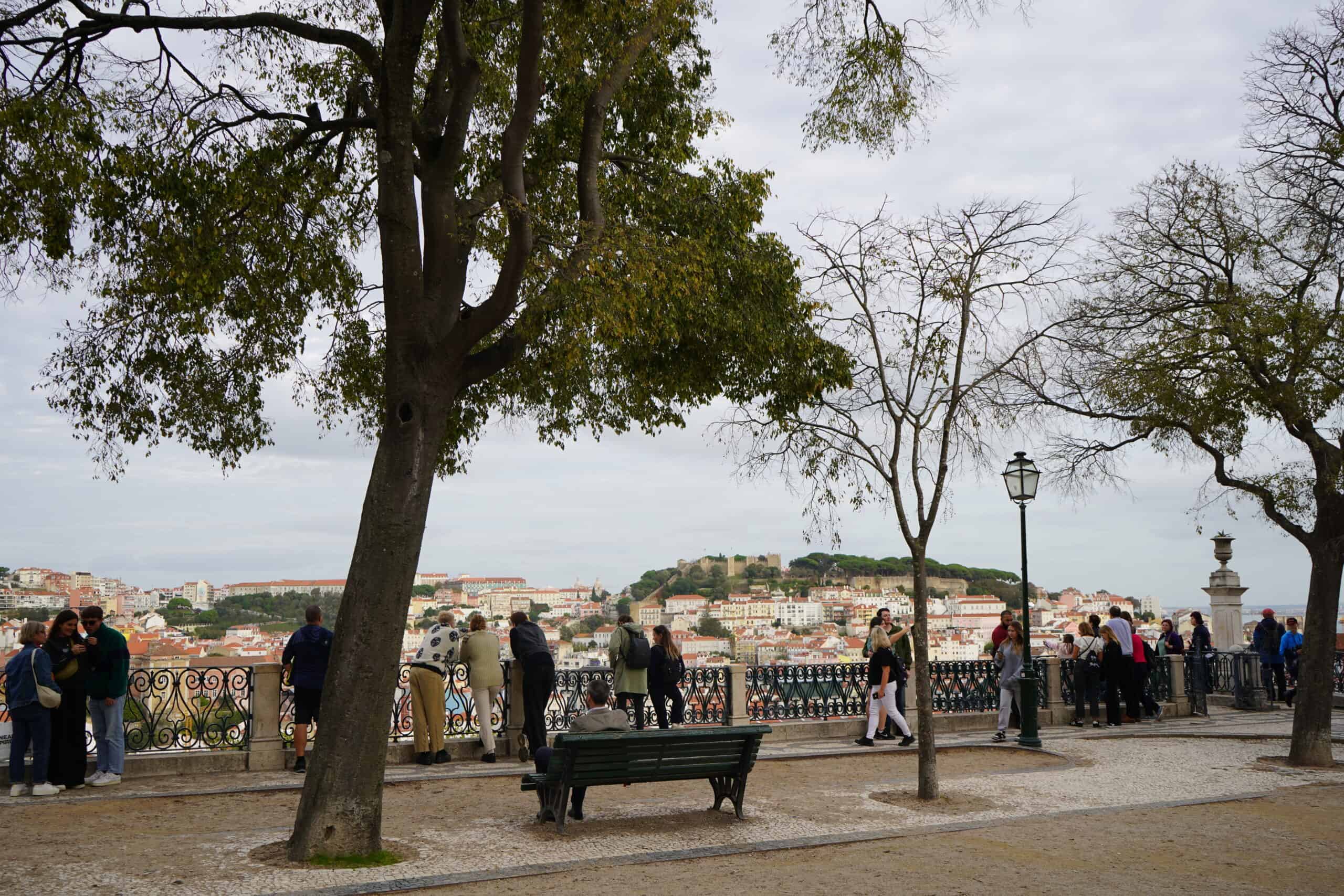
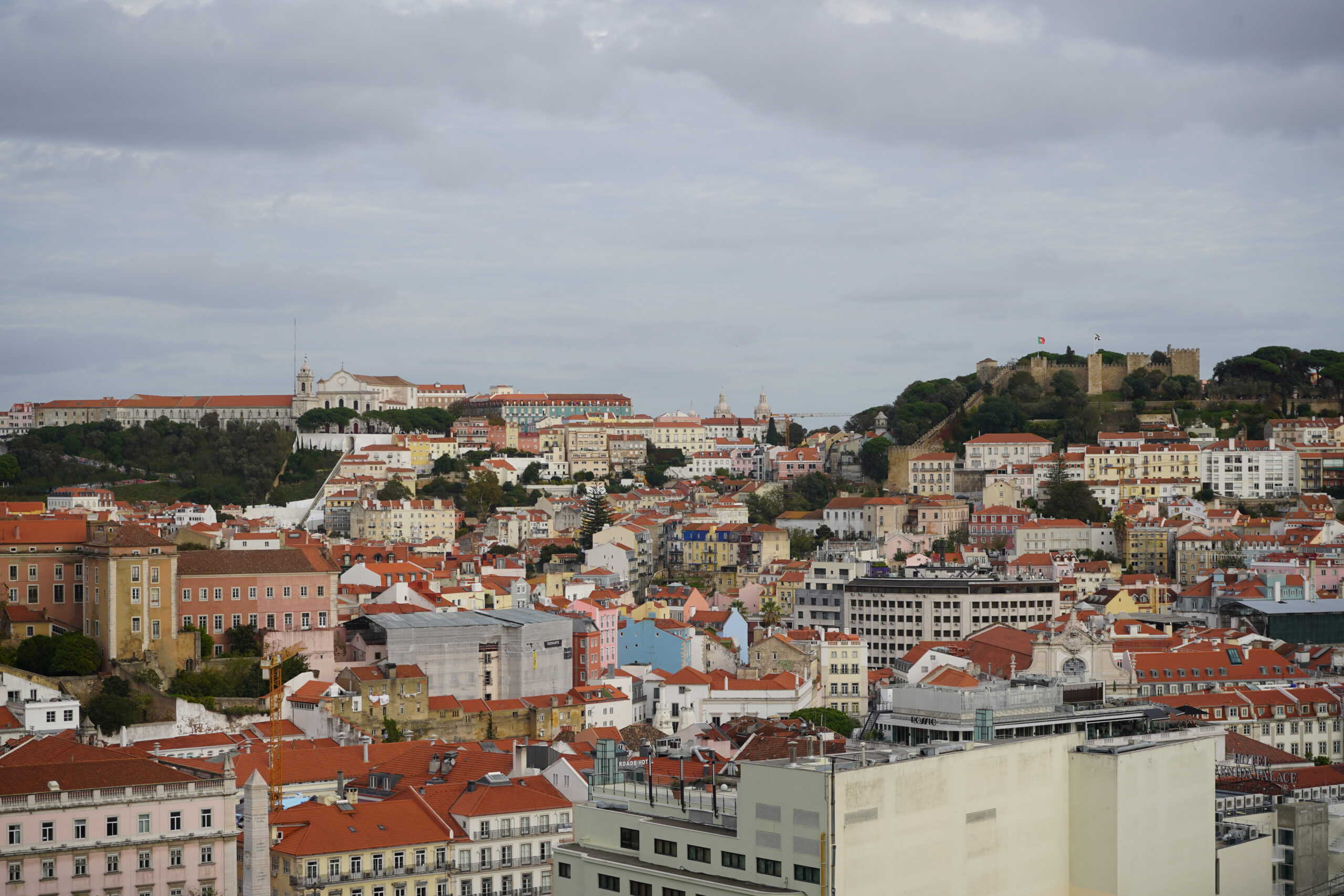
Next on my tour was Embaixada in Lisbon’s Príncipe Real district. It’s a concept store, housing lots of individual shops inside the 19th century, Arab style Ribeiro da Cunha Palace. Inside, boutiques take up each of the ornate individual rooms.
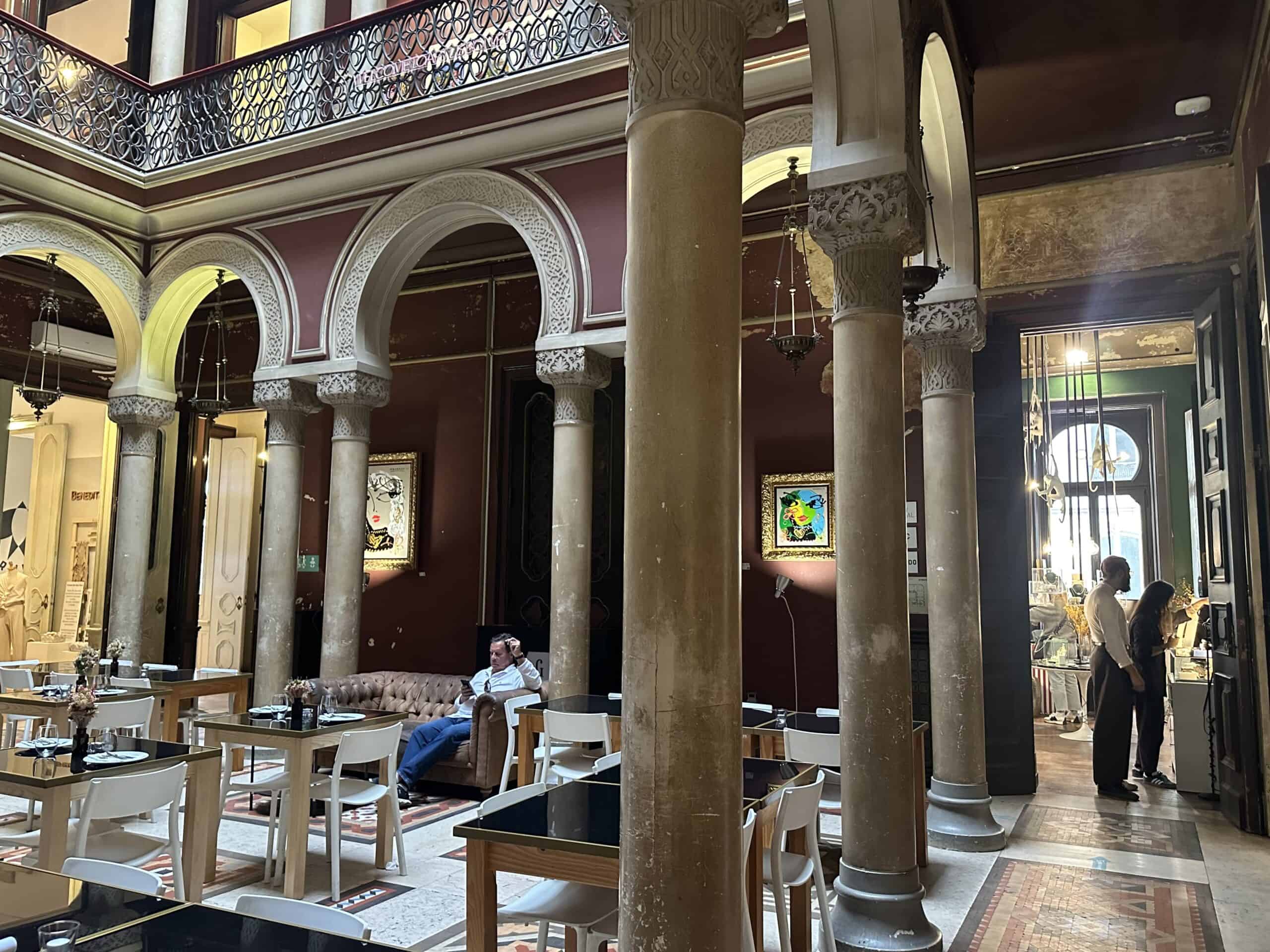
I had a wander around the ground floor before ascending the grand staircase to the upper level.
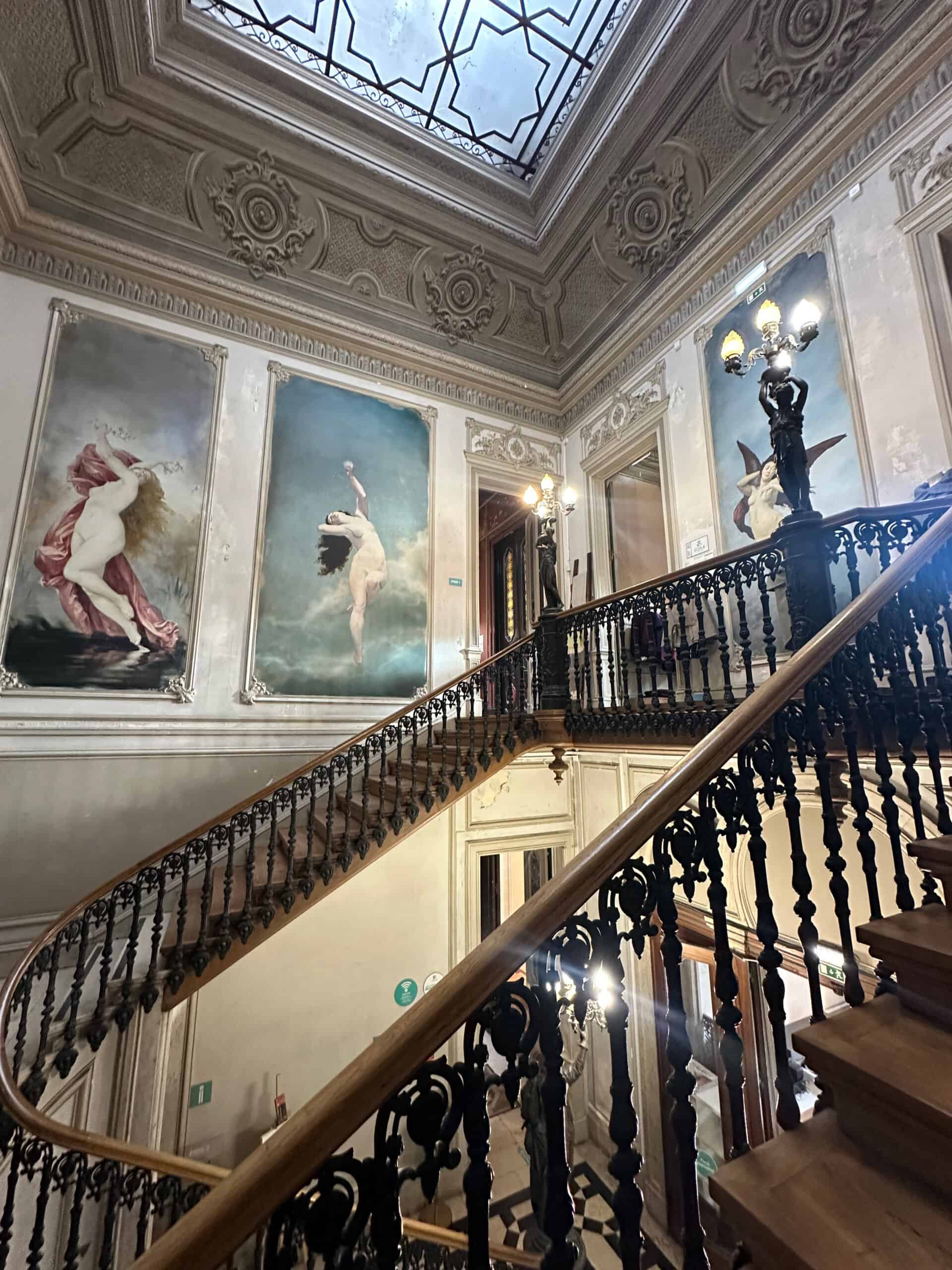
I ended up treating myself to a new shirt from Portuguese brand ISTO. They have an interesting proposition in that not only are their clothes made in Portugal, but they’re really transparent about their pricing – showing breakdowns of the costs associated with each.
After looking around more of the shops in Embaixada I headed down to Bairro Alto to look at a couple more stores. It was a pleasant walk and I stopped to marvel a couple of times at gorgeous tiled buildings. Look at the colour of that green!
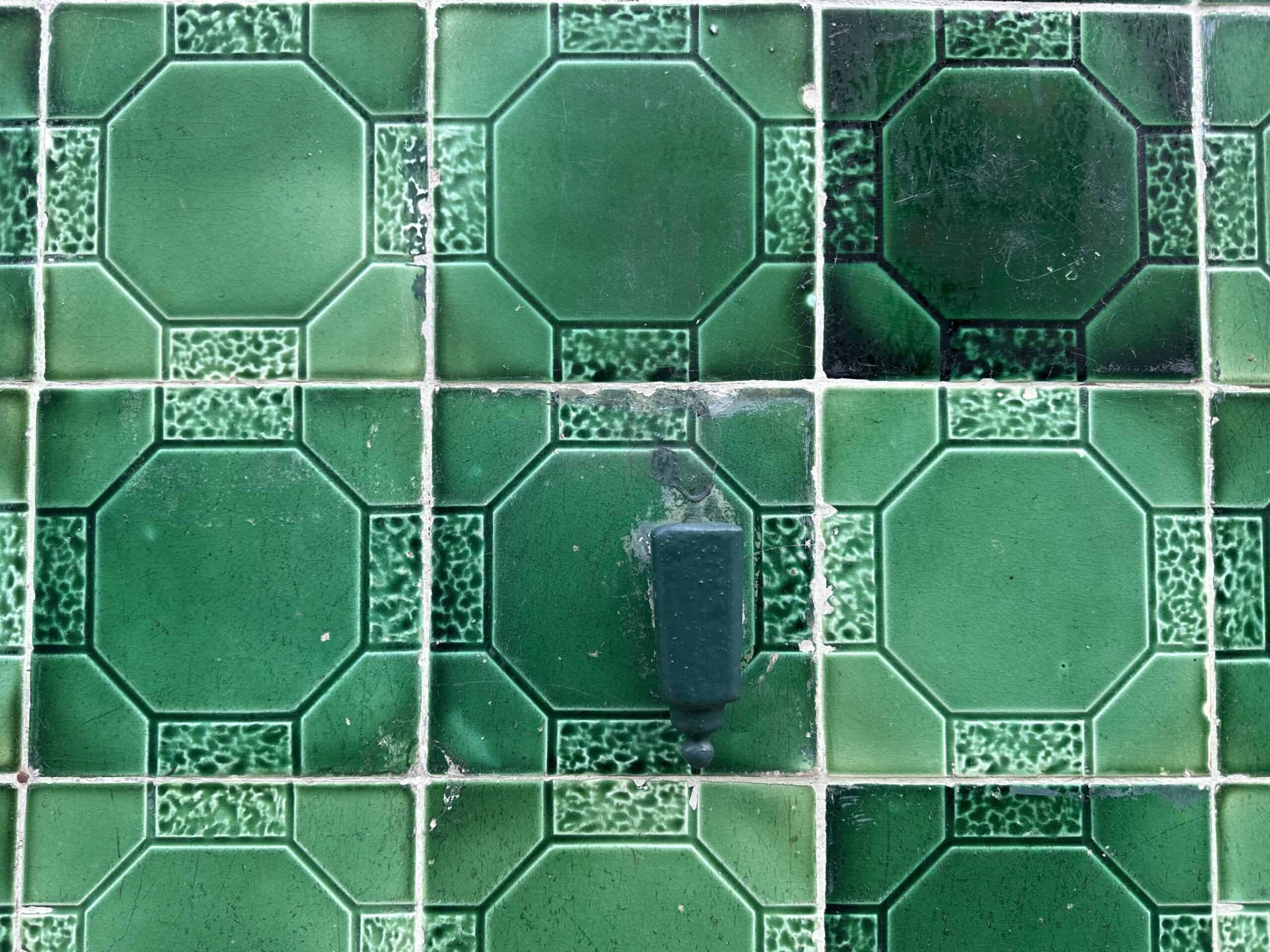
Lining the narrow streets were lots small individual stores, and I even passed an artisan furniture maker with a busy workshop.
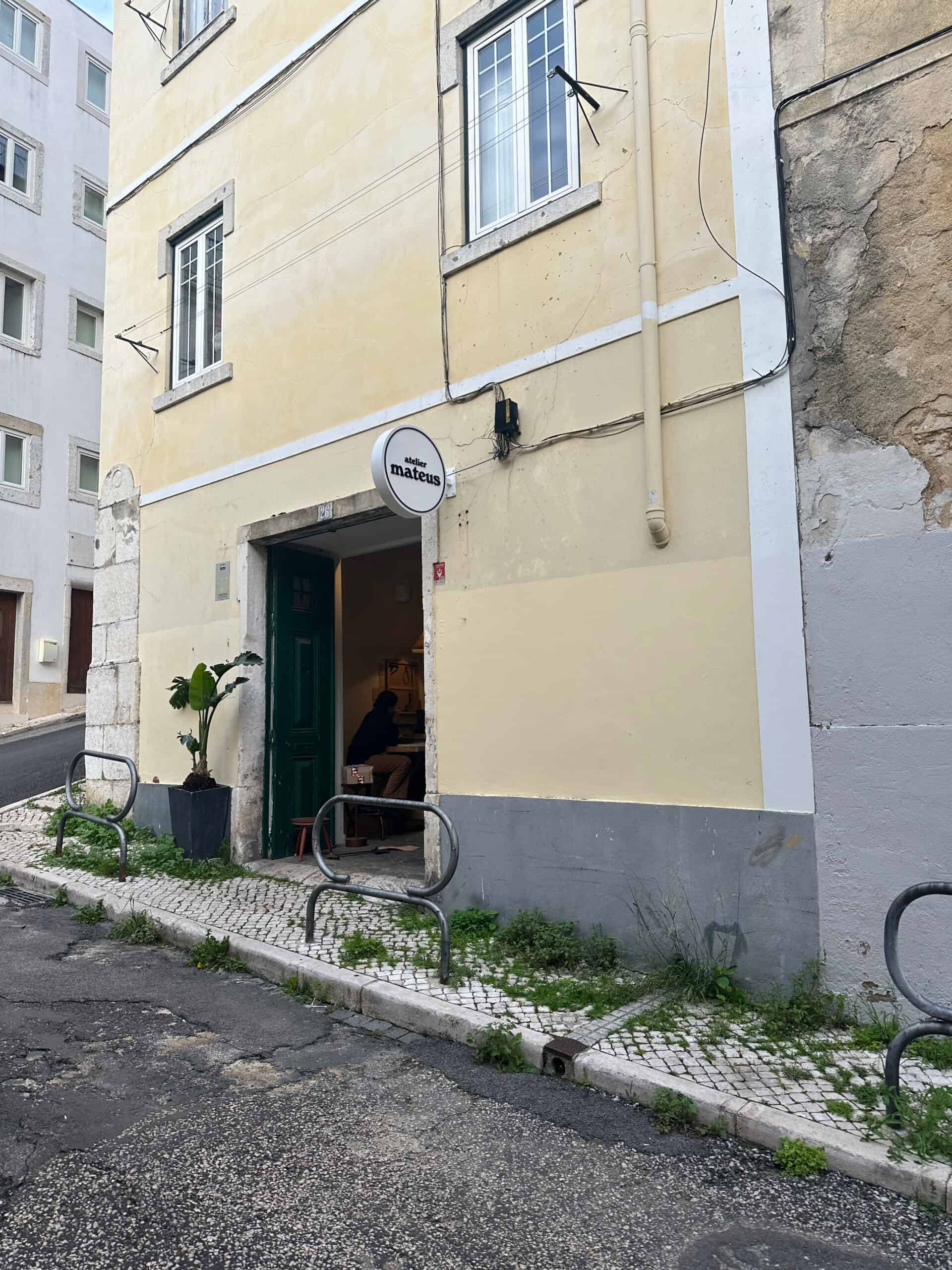
I checked out a small art print store and then one from another clothing brand I’d found and made a mental note to come back for a sweatshirt before walking a bit further to a branch of Gelato Davvero for an ice cream. I’d read they were known for their unusual flavours but there was nothing too adventurous on offer when I visited!
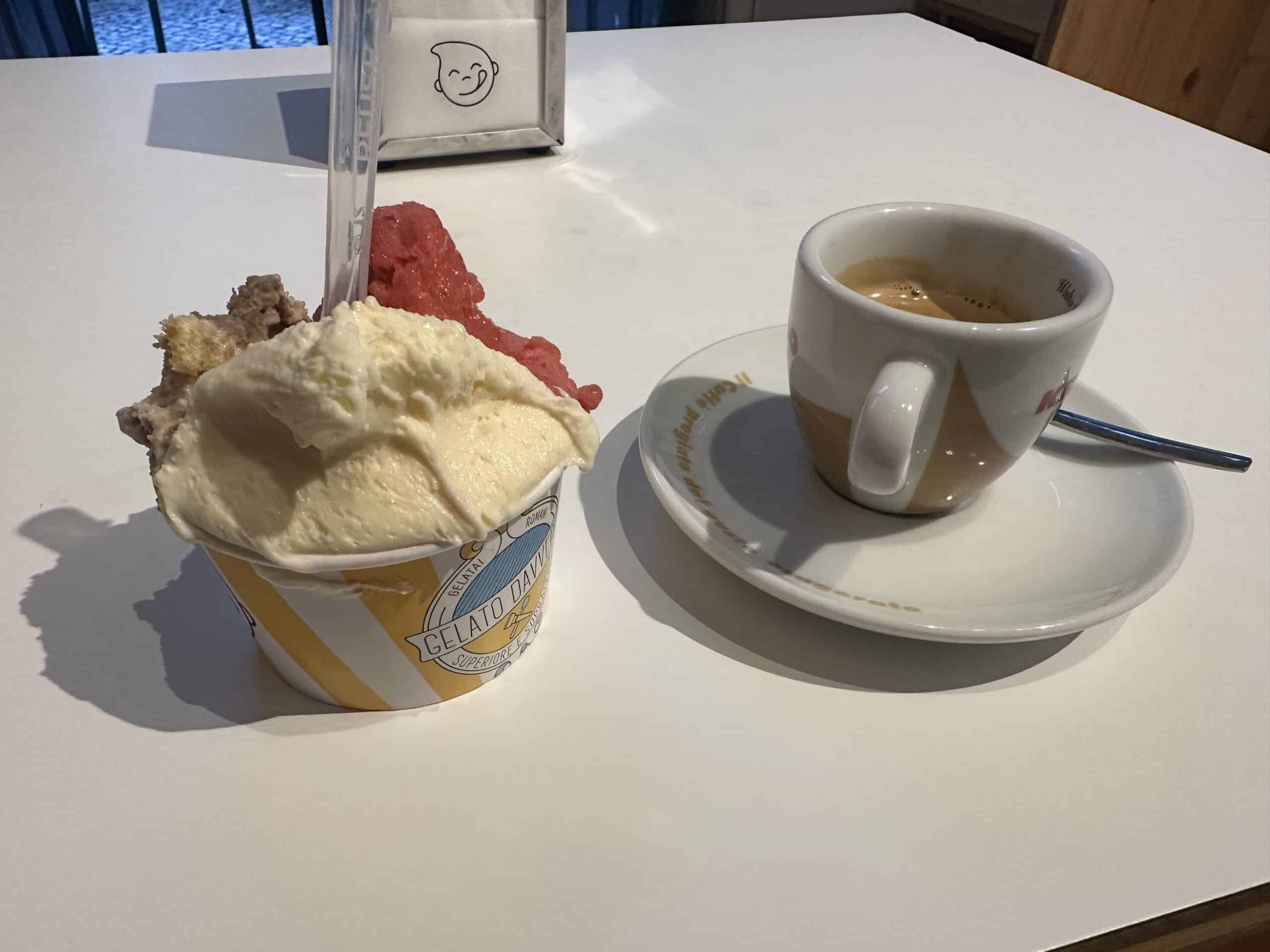
It was still good though! I spotted this little character peeking out a shop doorway…

…and popped into an English language bookstore I’d read about before starting the long walk back to the hotel.
There was just so much to look at on my walk – there were so many little traditional shops with cute window displays – like this one in a photographer’s window.

One display in particular caught my eye. I was pondering actually entering the shop this time but thought it looked a bit intimidating – there was just a small counter inside, beside walls lined with items.
My hand was forced when – as I was gazing through the window in the door – a man came up behind me and politely asked me to proceed. I was so glad he did though – as I stepped into Caza Vellas Loreto.
This shop has existed in Lisbon since 1789 – as a year below an ornate clock demonstrated.
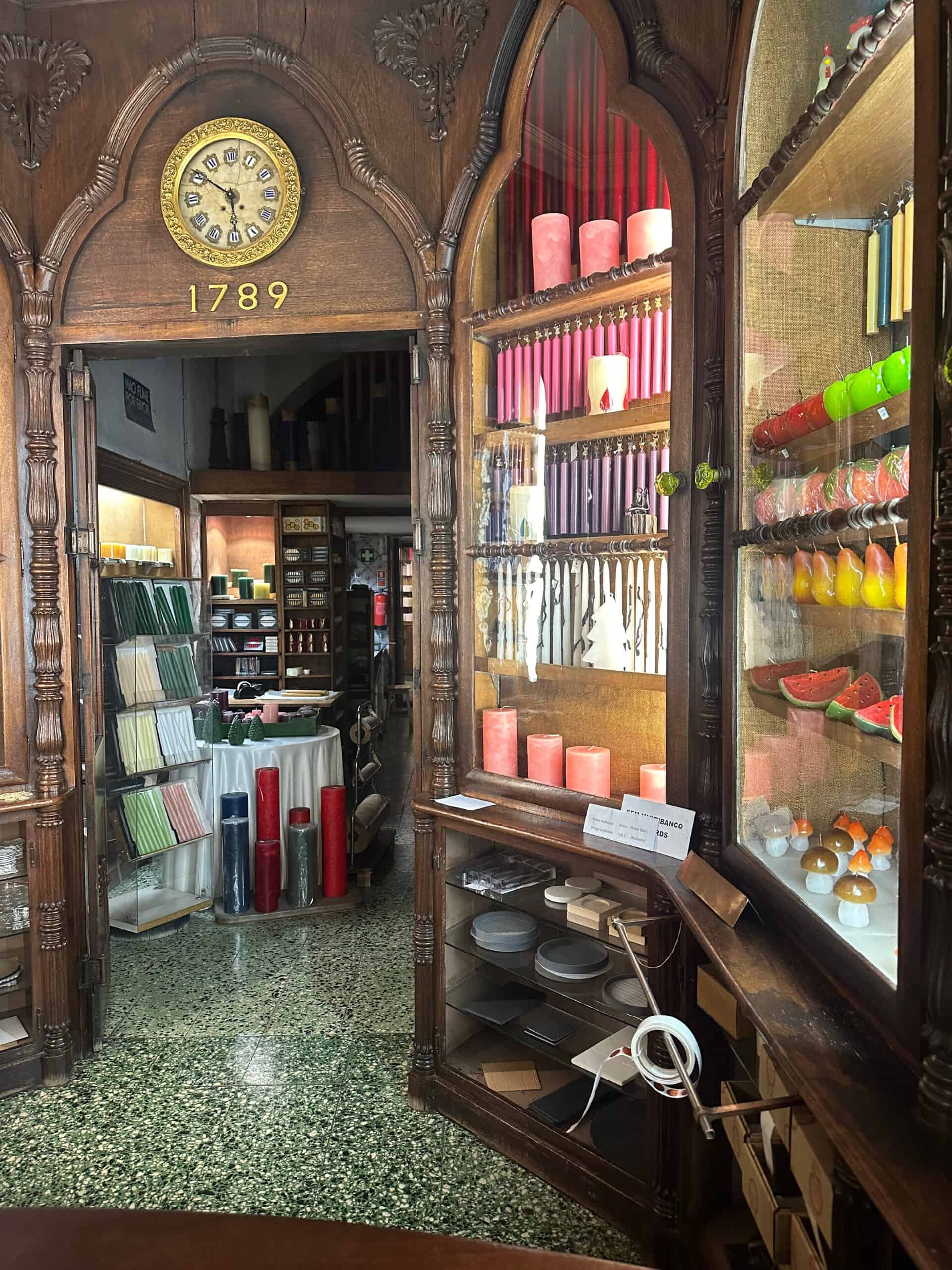
Glass cabinets built into the walls behind the counter showed candles in every colour imaginable, and others in the shape of fruit and vegetables. There were bright green glossy apples, slices of watermelon and little mushrooms. I stood slightly in awe for a good five minutes just gazing at them all.
I decided to buy two candles in the shape of a Christmas tree (one for me, one for a gift), but after disappearing through the back for what seemed like an eternity the lady came back to explain they had just been poured that afternoon and were still wet. How cool is that! I had it laid aside and promised I’d return the next day to collect it.
My lesson from that experience is that if something looks interesting go in and explore it! Apparently Caza Vellas Loreto is a bit of a Lisbon institution.
I felt I’d done absolutely bucketloads on my first full day in Lisbon, but even though I’d managed to check off loads of locations from my custom map into one day, I wasn’t done yet!
I headed back to the hotel, had a quick shower and changed before heading out on to Lisbon’s streets again, towards the Alfama part of the city.
Dinner with a difference
By now my watch told me that I’d already walked over 19km – I could feel my upper legs straining already as I climbed into Alfama’s narrow, quiet streets.
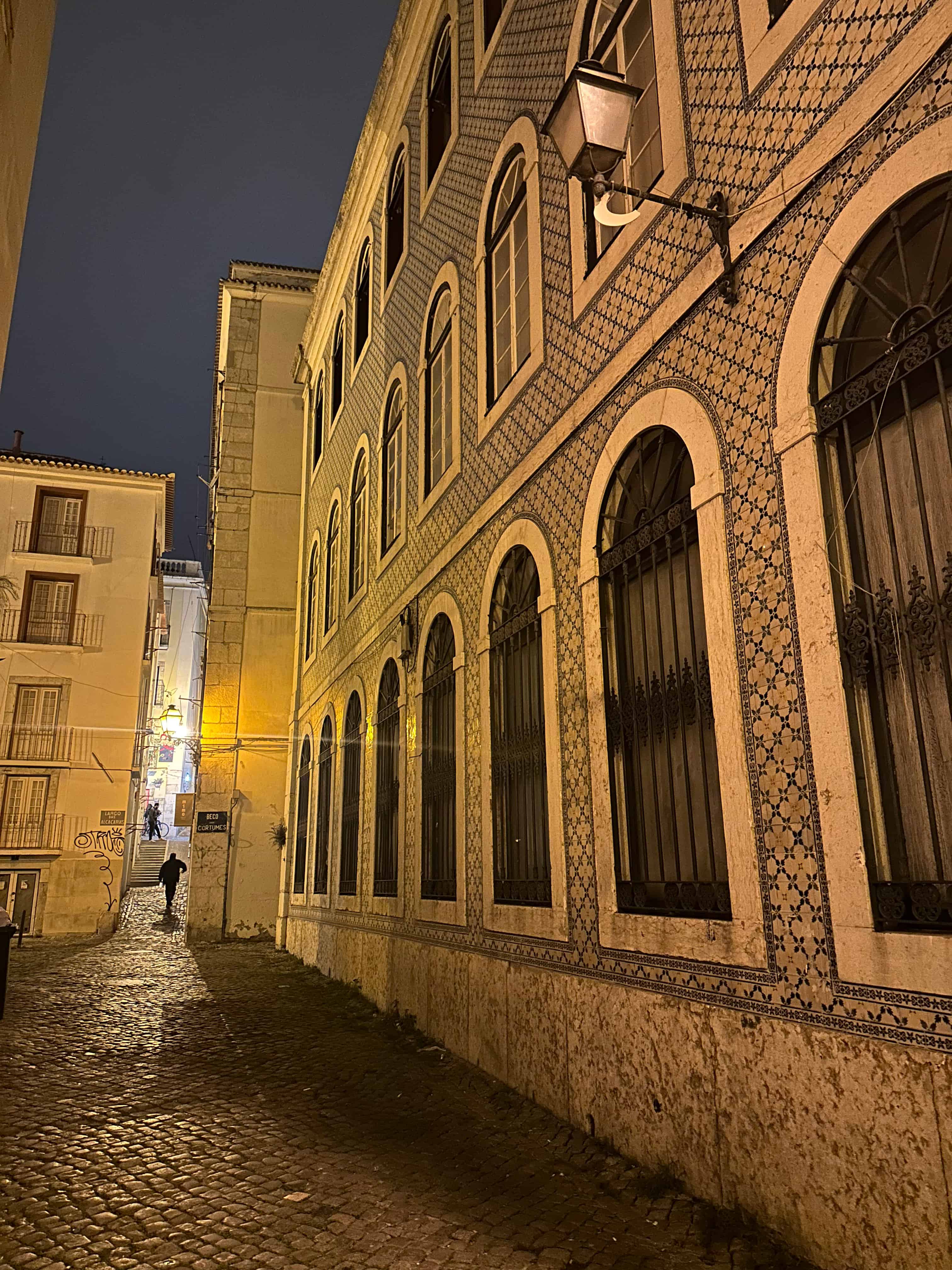
As I neared my destination, I passed a building dedicated to what I’d be experiencing later that evening…
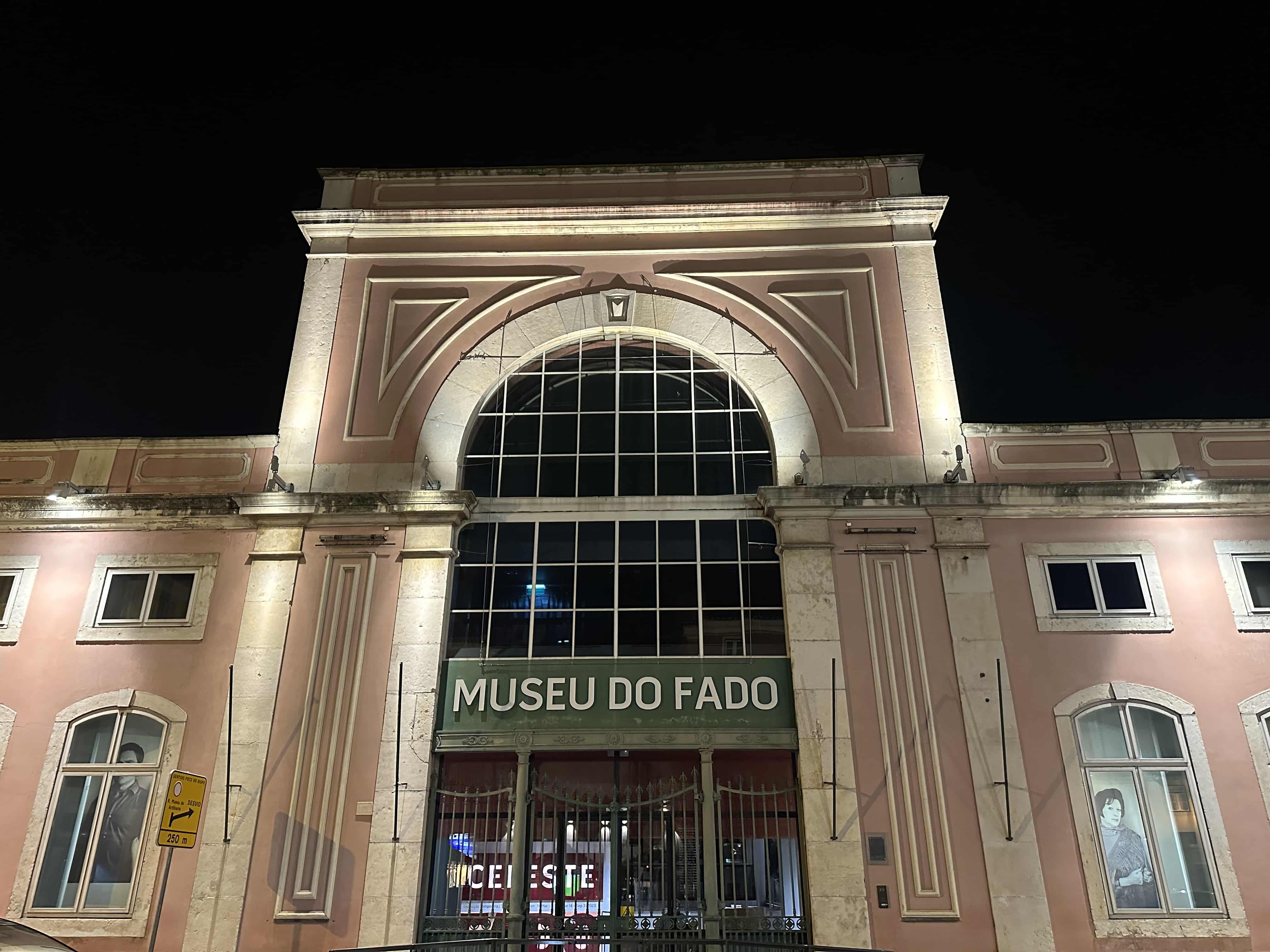
I’d been advised I’d need to book dinner at the restaurant. And I arrived bang on time for my 9.30pm reservation, but both Apple Maps and Google Maps threw me a curve ball at the last minute as I couldn’t find anywhere that looked like a restaurant or where the sign matched the restaurant name on my reservation.
Finally I asked a lady looking for custom in the street (for her restaurant lol) and she pointed to a pink building with no windows. I’d already walked past it a couple of times, but this was the entrance to Mesa De Frades.
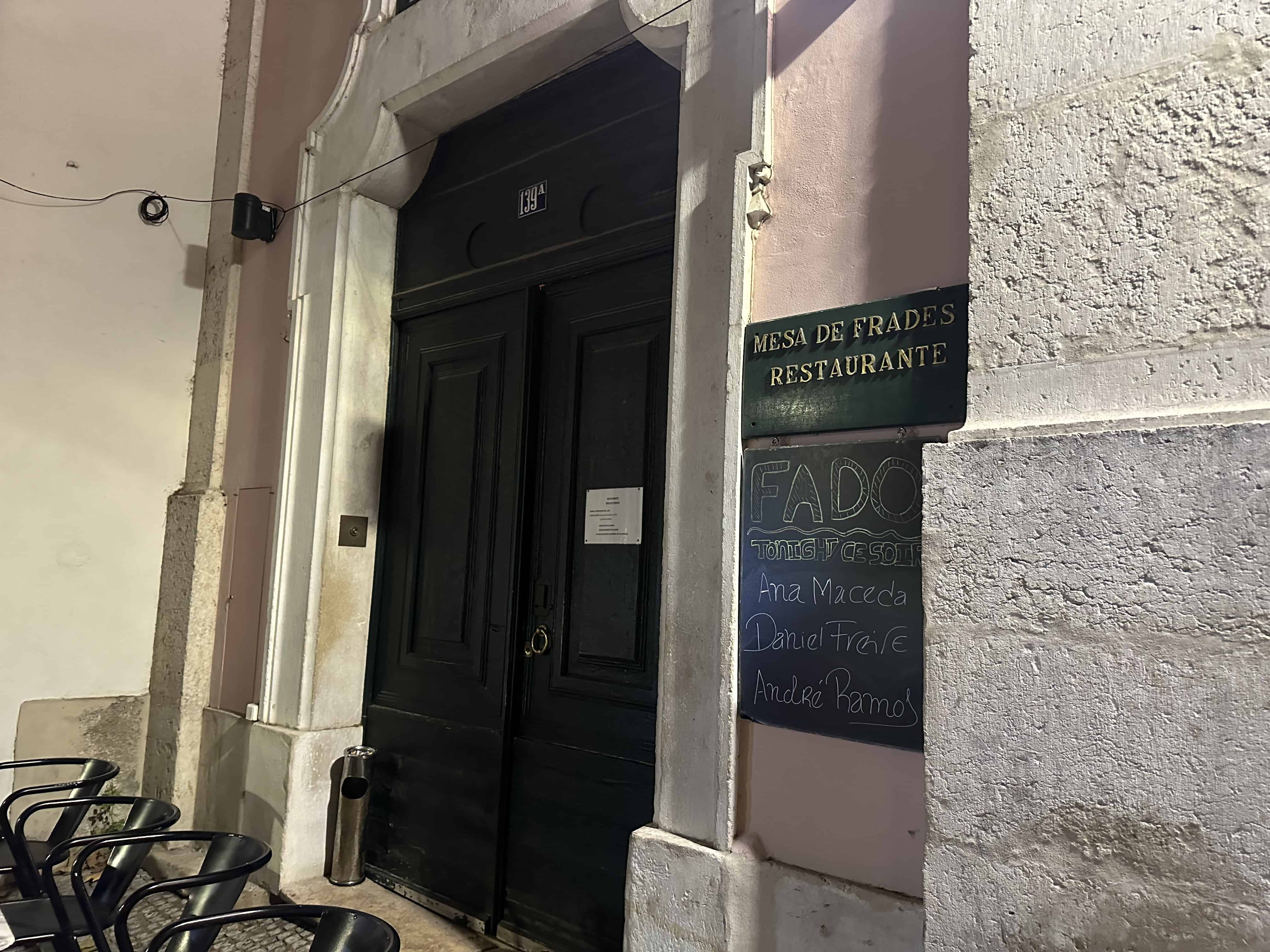
On entering the waitress told me that I could have a seat by the door or further into the narrow room with tables lining each side. I went for the latter.

I’d found Mesa De Frades after doing a bit of research on where I could find an authentic version of fado. It’s a genre of Portuguese music that’s associated with cafés and bars that has a soulful, melancholic style. There are lots of places to hear fado in Lisbon, but many of them seem to be aimed at tourists.
The setting here seemed authentic – inside, ornately tiled walls led up to a high ceiling. It felt almost like we were having dinner in an old church. But while I’d read this was a good spot for authentic fado, I’m not 100% convinced that was the case. It just had a bit of a commercial vibe to it – I think rather than booking dinner at a fado venue, a better bet might be to wander Alfama’s streets and follow the sound of music to a small bar.
Anyway! I was here now! And the setting was pleasant. I was briskly brought a selection of bread rolls and some pale looking fish pâté, along with a selection of olives and some greasy fried articles.

I’d read reviews of Mesa which said the food wasn’t really the star of the show, and I was beginning to understand what they meant. After a puff pastry dish I forgot to photograph, my main swiftly arrived – black pork with asparagus and tomato migas.

I’ll be honest – it tasted better than it looked but it did rather look like it had just been scooped out of some big dishes on a hotplate.
For dessert I went with chocolate mousse – or chocolate salami as the waitress called it.
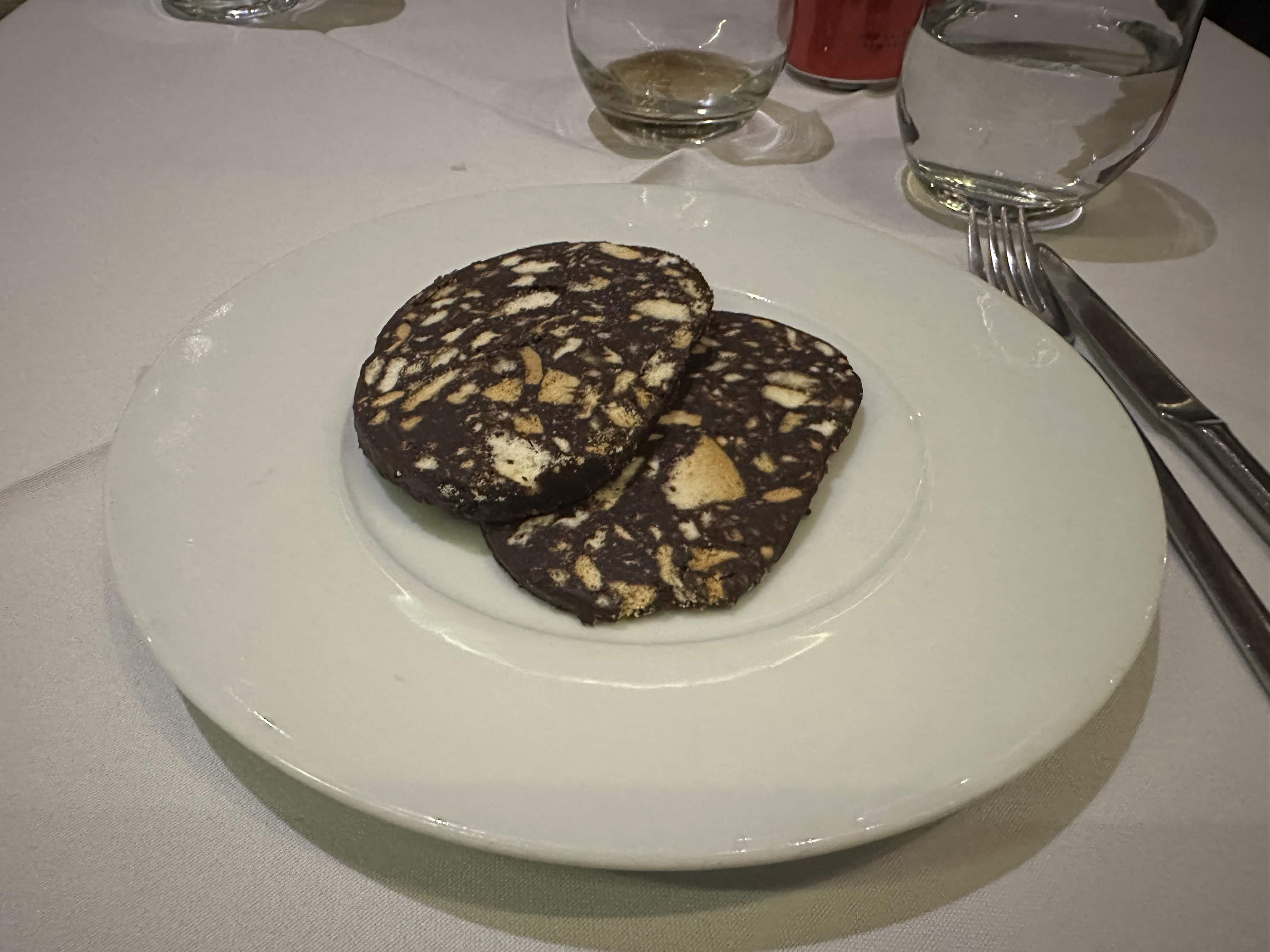
And there you have it. The €65 euro charge covered drinks and of course the entertainment, and I think it may be a bit of a better deal if you drink alcohol. But for me, who doesn’t, it felt a bit pricey for what it was.
Just before my dessert arrived, a quartet of people entered the restaurant and took a seat just in front of the two large, rather imposing entrance doors.
Soon the room was filled with the sound of fado. Three guitarists accompanied a lady as she sang in a pleading, emotional voice. After a couple of songs she was replaced by a man, and then a younger lady. Each sang about three songs.
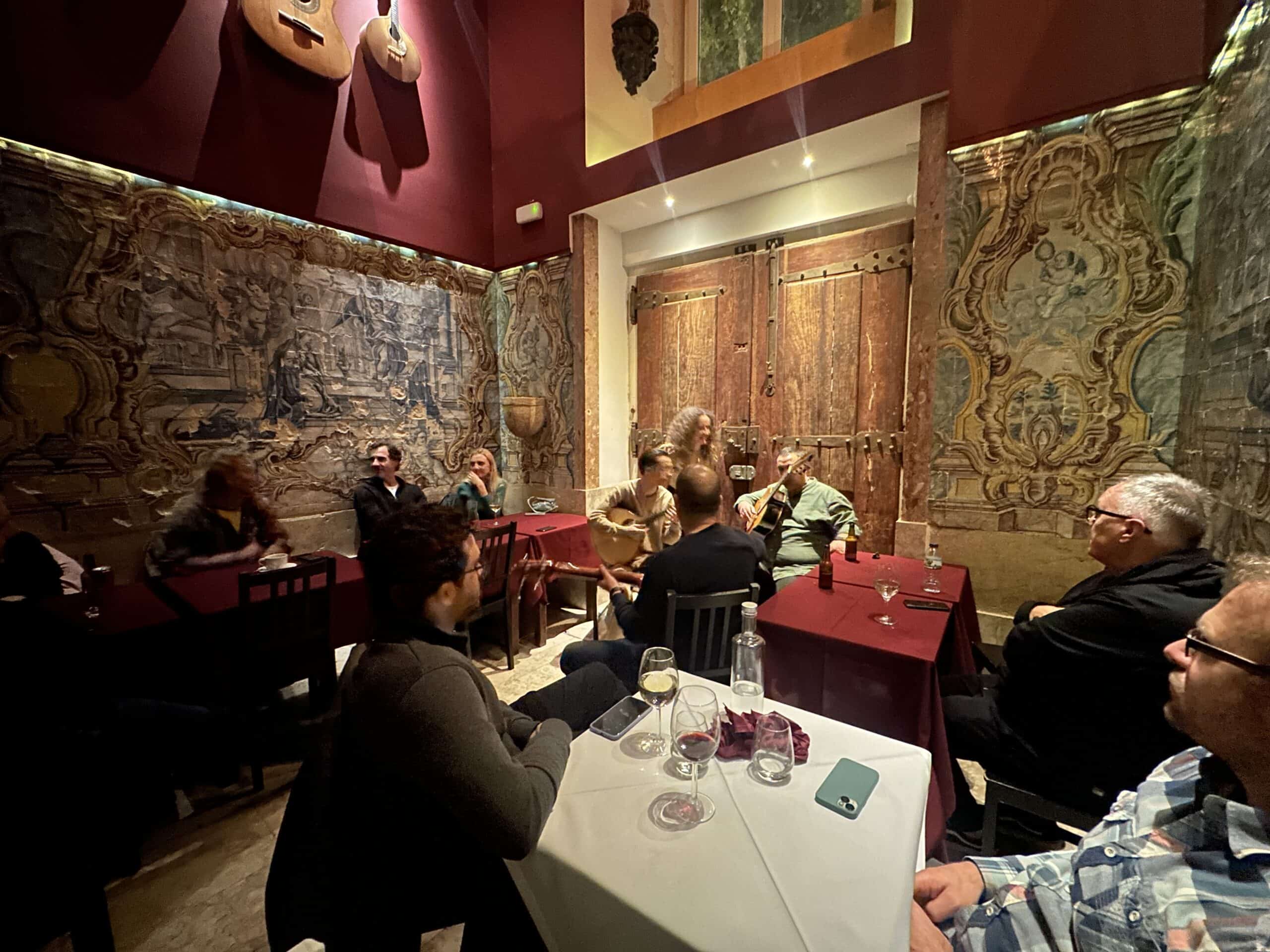
I’ve got to say it was kind of beautiful – the music and the setting combined just made it really atmospheric and it was a pleasant experience sitting watching the trio of musicians. The guitarists – the younger one in particular – seemed really, really skilled. His fingers slid rapidly over the guitar’s strings as the instrument’s soulful sound filled the air.
The two guitarists also seemed to be very prone to fits of giggles while they played which kept me extremely entertained and was a bonus in addition to the music.
I sometimes find in situations like this my attention wanders pretty quickly and I get a bit bored, but in this instance, I never felt that. I actually really enjoyed it – despite the decidedly mediocre food. The entertainment was due to go on until about 2 or 3am, but as the time slipped past midnight, I was beginning to feel absolutely exhausted.
I settled my bill, and left Mesa de Frades behind as I headed to the nearest metro station. Just after half past midnight I was climbing into bed – exhausted but having enjoyed a really packed day exploring just some of what Lisbon had to offer.